35 Dwarf Conifers by Feature
When most gardeners picture an eye-catching landscape plant, they envision colorful annuals, winding vines, and variegated perennials.
However, there is a whole industry devoted to creating and producing rare dwarf conifer specimen plants, or more simply, amazingly unique little trees and shrubs. These plants are full of character and have some surprising color variations that can add a unique pop of seasonal color to your landscape.
One of the major benefits of using dwarf conifer specimen plants is that most are evergreen, so they provide interest from late fall through early spring, when most other landscape plants are dormant and boring.
Some of the plants in our guide are classified as rare, meaning they can only be found through specialty growers. When you decide which plant is right for your landscape, contact a certified rare conifer grower to order high-quality, disease-free plants.
Some specimen plants benefit from careful pruning, while others are best left to their natural, sporadic growth habits.
In general, conifers with unique cones or needle colors should be gently candled or shaped to encourage new outer growth and amplify the unique features of the plant. Some of these conifers make stunning hedges or windbreaks, but gold or yellow conifers may need more shelter from the wind and sun to prevent leaf burn.
However, conifers with a unique or weeping form generally require little to no pruning, except to remove dead or damaged wood. These plants are better suited for solo focal points in the garden.
Skip ahead to the plants that interest you:
- Conifers for Year-Round Color
- Conifers for Winter Color
- Conifers for Spring Color
- Conifers with Showy Cones
- Weeping Conifers
- Conifers with Unique Forms
Conifers for Year-Round Color
Conifers in this category have been bred for unique needle and cone colors. Blue and silver conifers can add depth and contrast to a landscape, while gold and yellow conifers add a bright, cheery backdrop.
Of course, these plants can also stand alone as a specimen. With careful pruning (link to pruning page), these conifers will make excellent focal points in a landscape or container.
In general, blue or deep green conifers do well in full sun. Gold, yellow, or cream-colored conifers may have a more noticeable color difference in part shade.
Silberlocke Korean Fir
Abies koreana ‘Horstmann’s Silberlocke’Needle Color: Silver
Cone Color: Purple
This beautiful silver evergreen provides strong contrast in a landscape. Needles are tightly recurved, which gives the tree a firm, pyramidal shape. Upright, deep-purple cones provide seasonal, structural interest.
This conifer is considered to be low-maintenance and tolerates a variety of growing conditions.
Plant Profile:
- Height @ 10 Years: 6’
- Width @ 10 Years: 3’
- Hardiness Zone: 5-8
- Sun Exposure: Sun/Part Shade
- Soil Preference: Rich, moist, well-drained, slightly acidic
-
Pest Resistance:
- Essentially disease-free
- Deer
-
Pest Vulnerability:
- Aphids
- Adelgids
- Container Plant: No
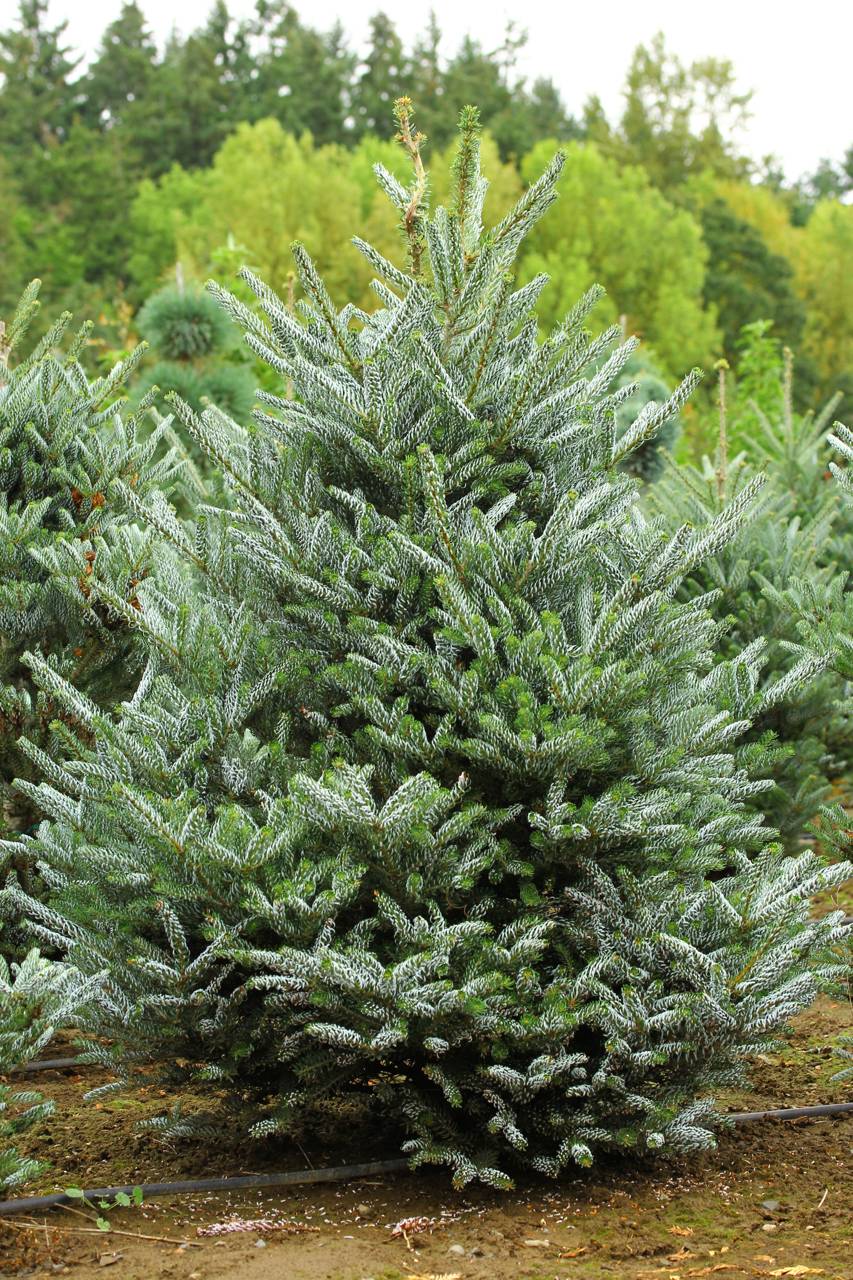
Golden Spreader Nordmann Fir
Abies nordmanniana ‘Golden Spreader’Needle Color: Yellow/Gold
Cone Color: N/A
This golden conifer adds warmth to a landscape or container garden. New growth is a soft, light green that slowly fades into a brilliant yellow color. This plant will grow into a small, wide globe that requires little pruning. Plant in part sun for a more pronounced color.
The standard Nordmann fir has an almost perfect, elegant pyramidal shape. The Golden Spreader cultivar has the same elegant form, but on a smaller scale.
Plant Profile:
- Height @ 10 Years: 2’
- Width @ 10 Years: 3’
- Hardiness Zone: 5-8
- Sun Exposure: Sun/Part Shade
- Soil Preference: Rich, moist, well-drained, slightly acidic
-
Pest Resistance:
- Essentially disease-free
- Deer
-
Pest Vulnerability:
- Aphids
- Adelgids
- Container Plant: Yes
.jpg)
Satellit Bosnian Pine
Pinus heldreichii (leucodermis) ‘Satellit’Needle Color: Deep Green
Cone Color: Blue
The bright blue cones of this dwarf pine provide a cool contrast to the long, dark green needles. This pine has an open, pyramidal shape with upright branches. Plant in full sun for best color.
This conifer, and its miniature cousin, the Smidtii Bosnian pine, prefer acidic soil but can tolerate alkaline soil, making them a perfect addition to landscapes with chalky soils.
Plant Profile:
- Height @ 10 Years: 8’
- Width @ 10 Years: 3’
- Hardiness Zone: 5-8
- Sun Exposure: Sun
- Soil Preference: Rich, moist, well-drained, slightly acidic-slightly alkaline
-
Pest Resistance:
- Deer
-
Pest Vulnerability:
- Aphids
- Adelgids
- Sawflies
- Pine shoot moth
- Container Plant: No
.jpg)
Smidtii Bosnian Pine
Pinus heldreichii (leucodermis) ‘Smidtii’Needle Color: Deep Green
Cone Color: Dark Purple
This little evergreen is the miniature cousin of the Satellit Bosnian Pine. The needles are shorter and more compact, and the branches form a tight, round globe. The cones are small, but they are a beautiful blue/purple color before maturing into a dark brown.
Plant Profile:
- Height @ 10 Years: 1’
- Width @ 10 Years: 1’
- Hardiness Zone: 5-8
- Sun Exposure: Sun
- Soil Preference: Rich, moist, well-drained, slightly acidic-slightly alkaline
-
Pest Resistance:
- Deer
-
Pest Vulnerability:
- Aphids
- Adelgids
- Sawflies
- Pine shoot moth
- Container Plant: Yes
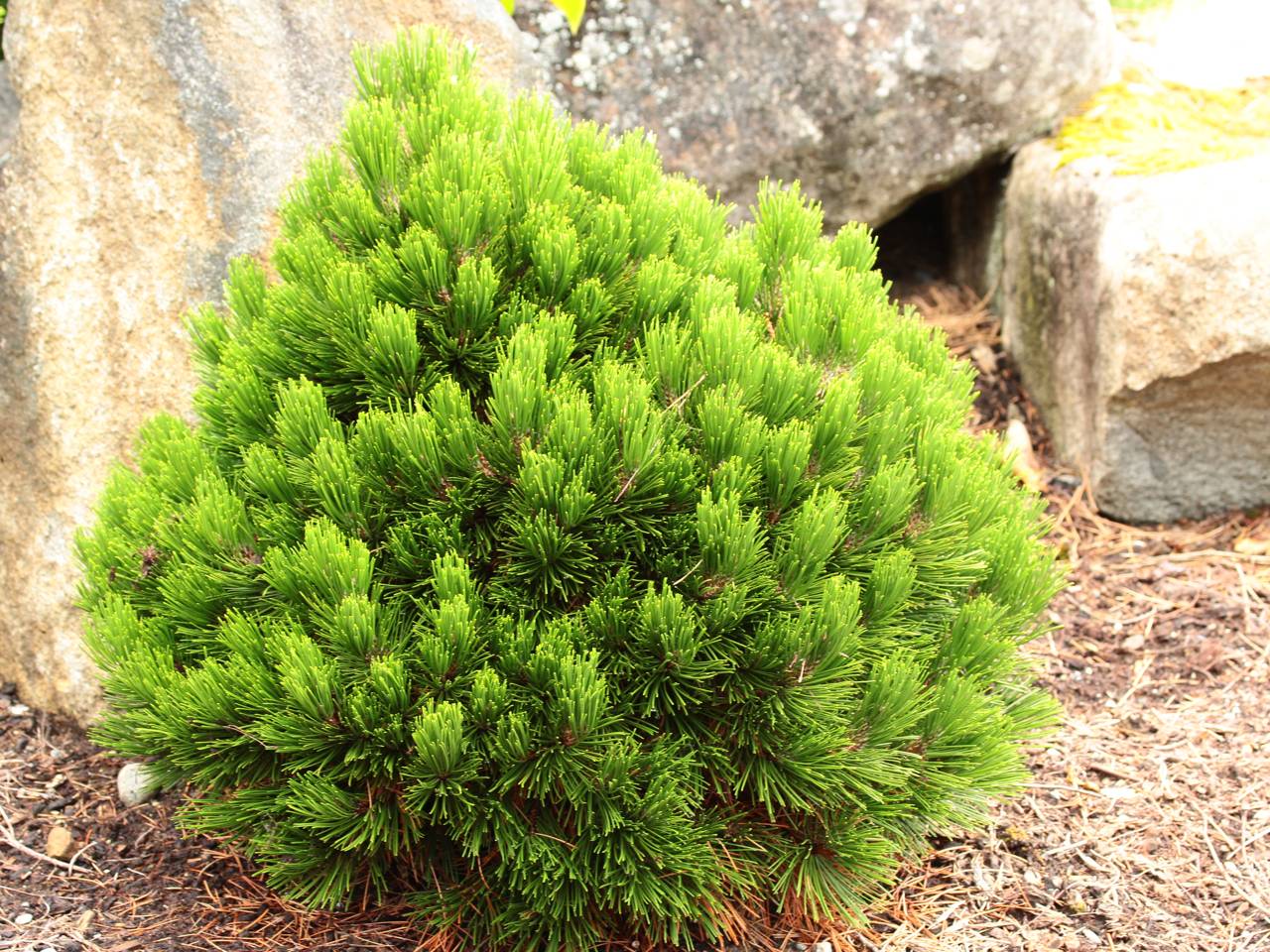
Bergman Japanese White Pine
Pinus parviflora ‘Bergman’Needle Color: Blue/Green
Cone Color: Bright Red
This pine keeps a dense, pyramidal shape despite colorful, twisted needles. In the spring, bright red male cones provide an additional layer of visual interest. This pine is more heat tolerant than other conifers in this category. It also tolerates drought and salt spray.
This interesting cultivar began life in Pennsylvania in the 1960s as a distinct seedling in a nursery. The growers propagated the plant, and in 2011, it won the ACS Collectors Conifer of the Year award.
Plant Profile:
- Height @ 10 Years: 6’
- Width @ 10 Years: 3’
- Hardiness Zone: 5-9
- Sun Exposure: Sun
- Soil Preference: Rich, moist-dry, well-drained, slightly acidic-slightly alkaline
-
Pest Resistance:
- Deer
-
Pest Vulnerability:
- Pine wilt
- Container Plant: No
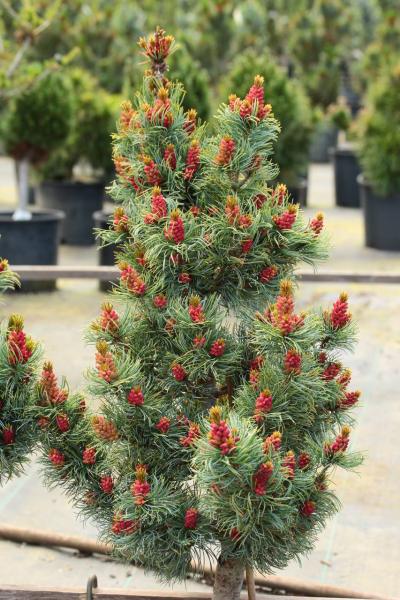
Edit Colorado Spruce
Picea pungens ‘Edit’Needle Color: Silvery Blue
Cone Color: Red/Brown
This striking Colorado spruce cultivar has a frosted, silvery blue color and a dense growth habit. The cones are a bright red color and then fade to brown as they mature. This evergreen maintains a dense, bushy profile throughout its life, making it a strong focal point in a landscape.
This spruce tolerates drought and salt spray.
Plant Profile:
- Height @ 10 Years: 6’
- Width @ 10 Years: 4’
- Hardiness Zone: 4-8
- Sun Exposure: Sun
- Soil Preference: Rich-sandy, moist-dry, well-drained, slightly acidic
-
Pest Resistance:
- Deer
-
Pest Vulnerability:
- Aphids
- Adelgids
- Conifer red spider mite
- Container Plant: No
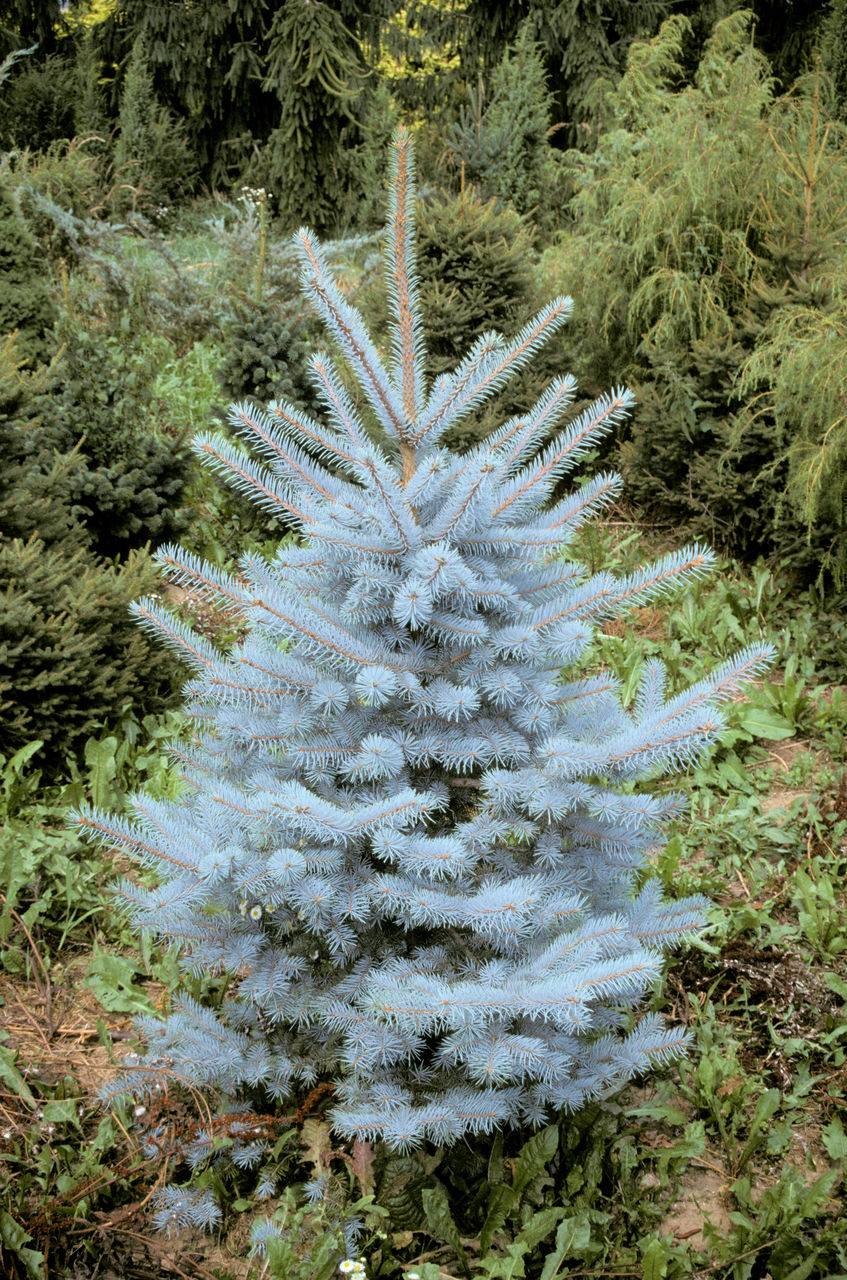
Mushroom Japanese Cedar
Cryptomeria japonica ‘Mushroom’Needle Color: Bronze/Purple
Cone Color: Brown
This dwarf conifer has unique, coarse needles that turn a deep bronze/purple color in the fall. The slow, mounding growth habit combined with drooping branches results in a dense, mature, weeping globe. Hence, the name mushroom.
Although this conifer performs best in full sun, it dries out quickly in windy areas, so plant it in a sheltered part of your landscape.
Plant Profile:
- Height @ 10 Years: 7’
- Width @ 10 Years: 8’
- Hardiness Zone: 5-9
- Sun Exposure: Sun
- Soil Preference: Rich, moist-dry, well-drained, slightly acidic-slightly alkaline
-
Pest Resistance:
- Essentially disease-free
-
Pest Vulnerability:
- Nothing of significance
- Container Plant: Yes
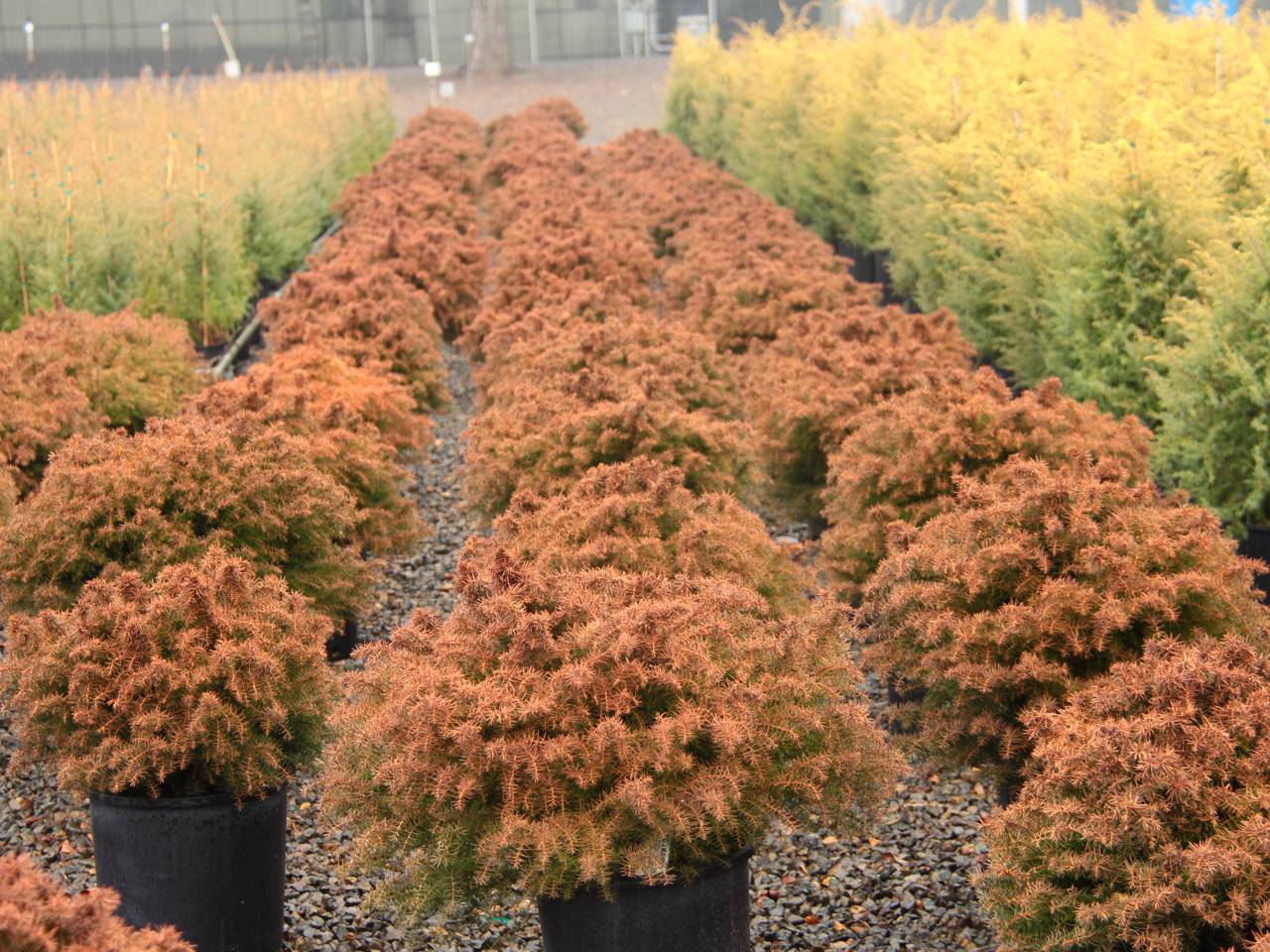
Coral Tower Japanese Maple
Acer palmatum ‘Sango-Kaku’Leaf Color: Light Pink in spring, light green in summer, bright yellow in fall
Bark Color: Bright Red
This colorful Japanese maple provides visual interest during all four seasons. The leaves continue to change color throughout the season until they drop in the fall, revealing the beautiful coral-red bark. This ornamental tree provides a beautiful accent piece that has the lacey, delicate appearance of a Japanese maple with sharp, striking color changes.
Although this tree performs well under most light conditions, the color will be most profound in part shade.
Plant Profile:
- Height @ 10 Years: 7’
- Width @ 10 Years: 5’
- Hardiness Zone: 5-9
- Sun Exposure: Sun/Shade
- Soil Preference: Rich, moist-dry, well-drained, slightly acidic-slightly alkaline
-
Pest Resistance:
- Rabbit
-
Pest Vulnerability:
- Horse chestnut scale
- Aphids
- Verticillium wilt
- Container Plant: No
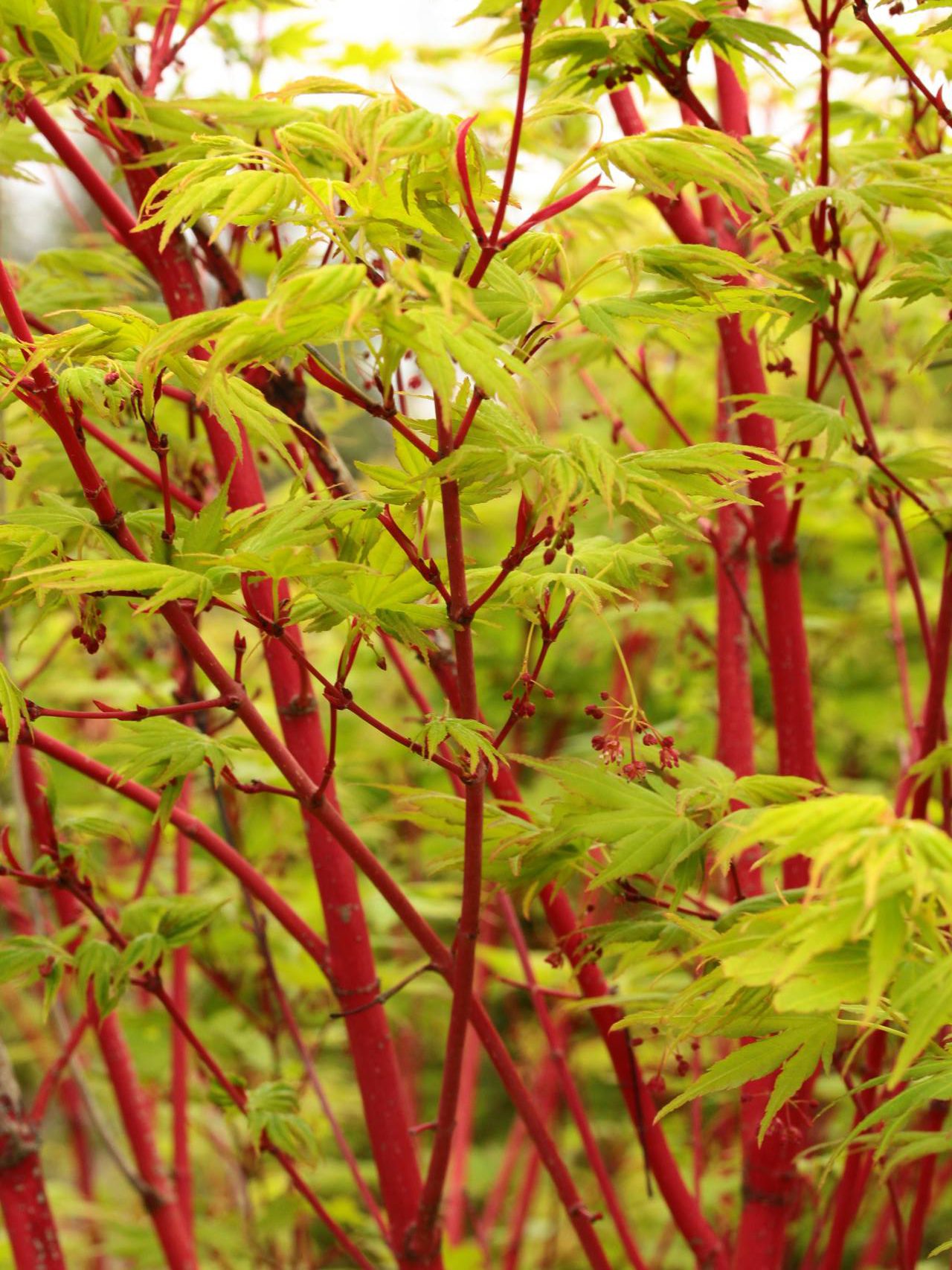
Conifers for Winter Color
These conifers have a similar color change as deciduous trees in the fall, except most of the plants in this category will fade to a deep gold or bronze color throughout the winter, and then regain their green color in the spring.
Conifers that change color during the winter provide excellent seasonal interest while the rest of the garden is dormant.
Chief Joseph Lodgepole Pine
Pinus contorta var. latifolia ‘Chief Joseph’Needle Color: Gold
Cone Color: Brown
Chief Joseph lodgepole pine is a rare specimen tree that makes a bold statement in any landscape. This unique pine fades into a brilliant gold color during the fall/winter season. The mature plant has an open, pyramidal shape and bright, twisted needles.
This plant benefits from annual candling (link to pruning page) and occasional shaping to keep a more compact structure.
Plant Profile:
- Height @ 10 Years: 4’
- Width @ 10 Years: 2’
- Hardiness Zone: 5-8
- Sun Exposure: Sun/Part Sun
- Soil Preference: Rich, moist-dry, well-drained, slightly acidic
-
Pest Resistance:
- Deer
-
Pest Vulnerability:
- Aphids
- Adelgids
- Sawflies
- Pine shoot moth
- Pine needle cast
- Container Plant: No
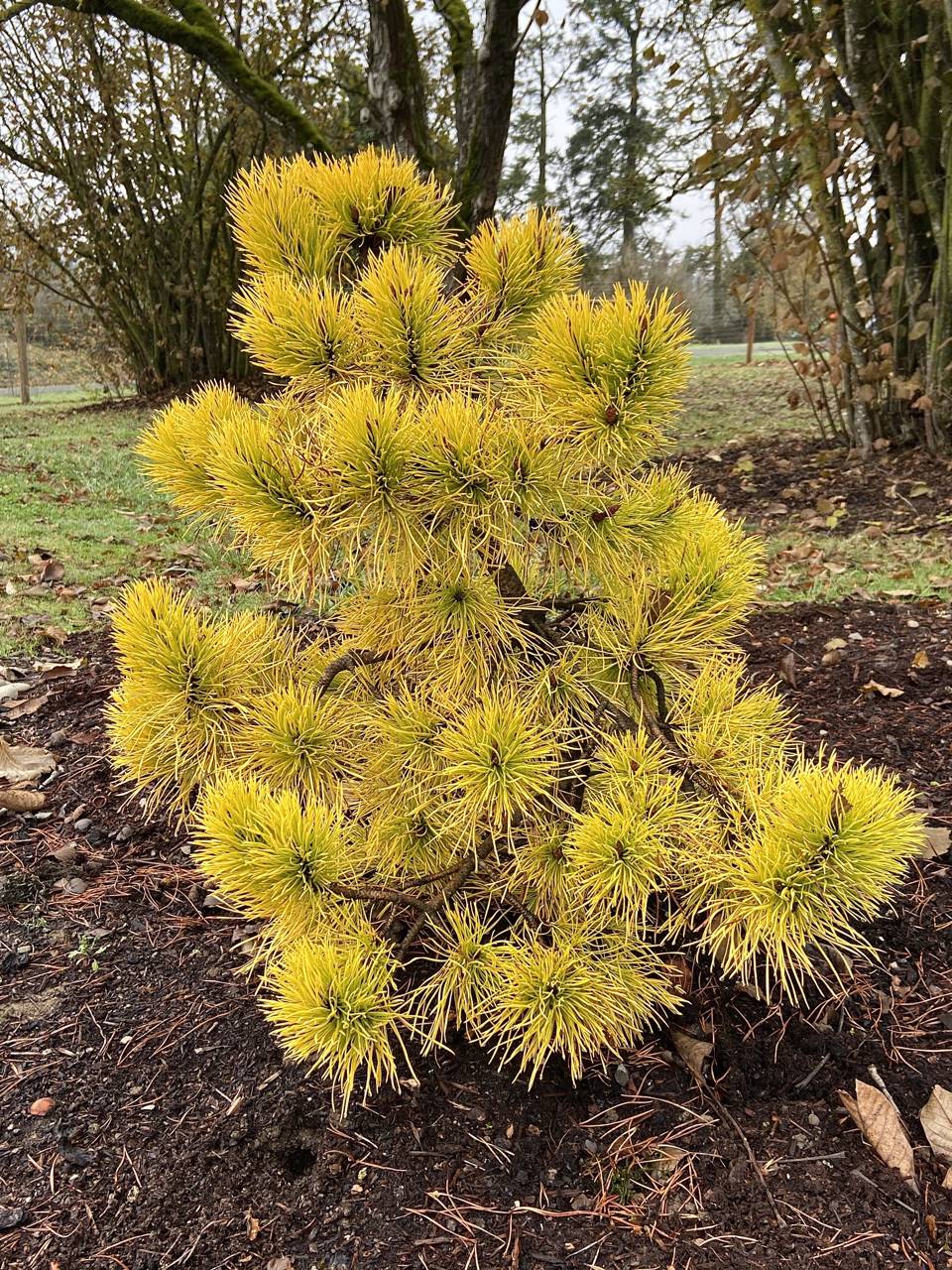
Moseri Scots Pine
Pinus sylvestris ‘Moseri’Needle Color: Gold
Cone Color: Brown
The Moseri Scots Pine has a unique form and brilliant fall color. Old needles can be up to 4x as long as new growth, which gives the plant an overall full, shaggy look. This is amplified by the color change in the fall as the needles fade from a deep green to a bright yellow gold.
This plant benefits from annual candling (link to pruning page) and occasional shaping to keep a more compact structure.
Plant Profile:
- Height @ 10 Years: 4’
- Width @ 10 Years: 2’
- Hardiness Zone: 4-8
- Sun Exposure: Sun
- Soil Preference: Rich, moist-dry, well-drained, slightly acidic
-
Pest Resistance:
- Deer
-
Pest Vulnerability:
- Dothistroma needle blight
- Red band needle blight
- Needle cast
- Pine stem rust
- Container Plant: No
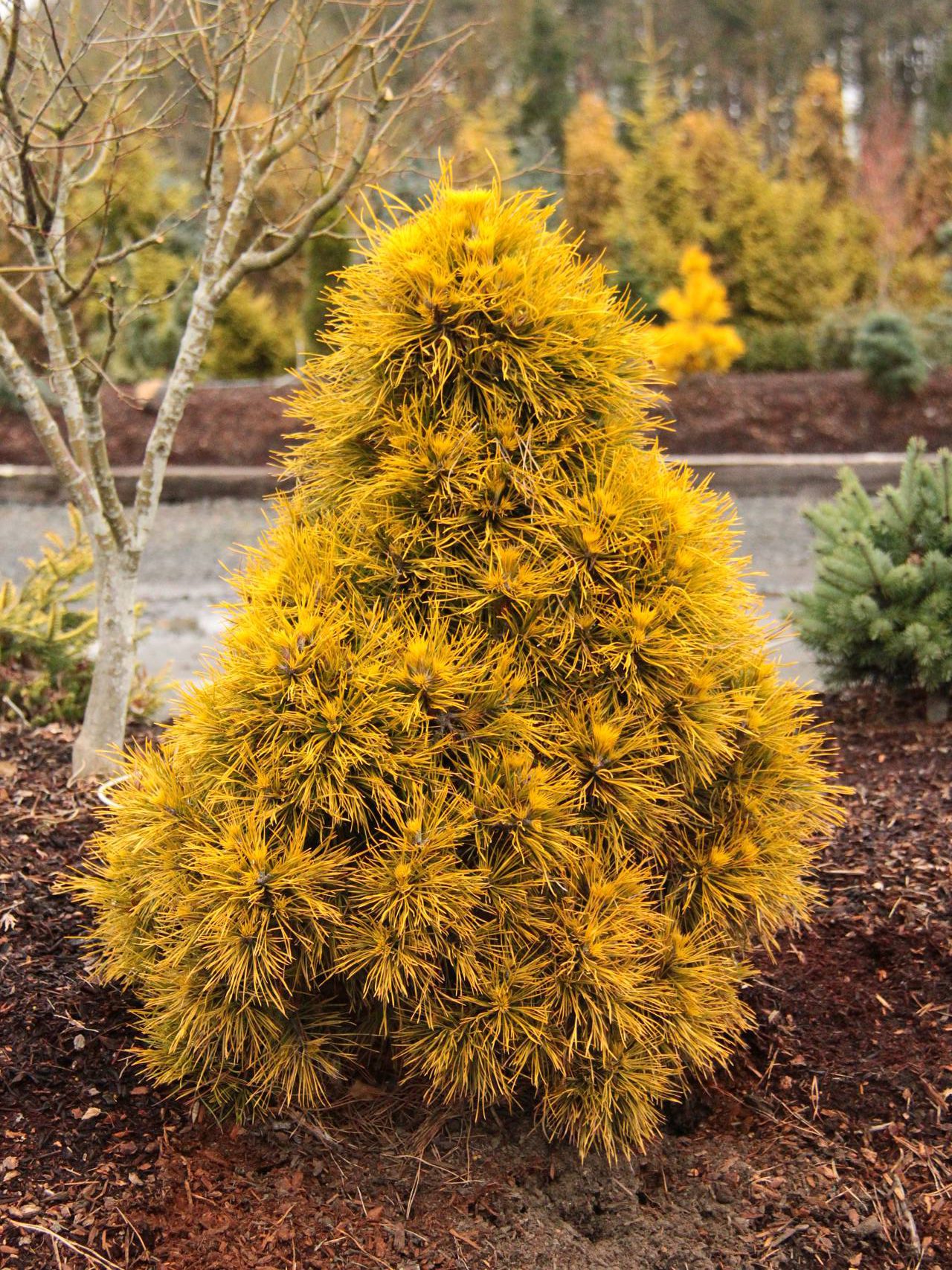
Louie Eastern White Pine
Pinus strobus ‘Louie’Needle Color: Gold
Cone Color: Brown
This dwarf pine begins life as a little globe, and then matures into a small, golden pyramid. Needles are light green and frosted with yellow during the summer, but fade to a deep gold during the fall and winter seasons.
This plant benefits from annual candling (link to pruning page) and occasional shaping to keep a more compact structure.
Plant Profile:
- Height @ 10 Years: 6’
- Width @ 10 Years: 3’
- Hardiness Zone: 4-8
- Sun Exposure: Sun
- Soil Preference: Rich, moist-dry, well-drained, slightly acidic-slightly alkaline
-
Pest Resistance:
- Deer
- Rabbit
-
Pest Vulnerability:
- Nothing of significance
- Container Plant: No
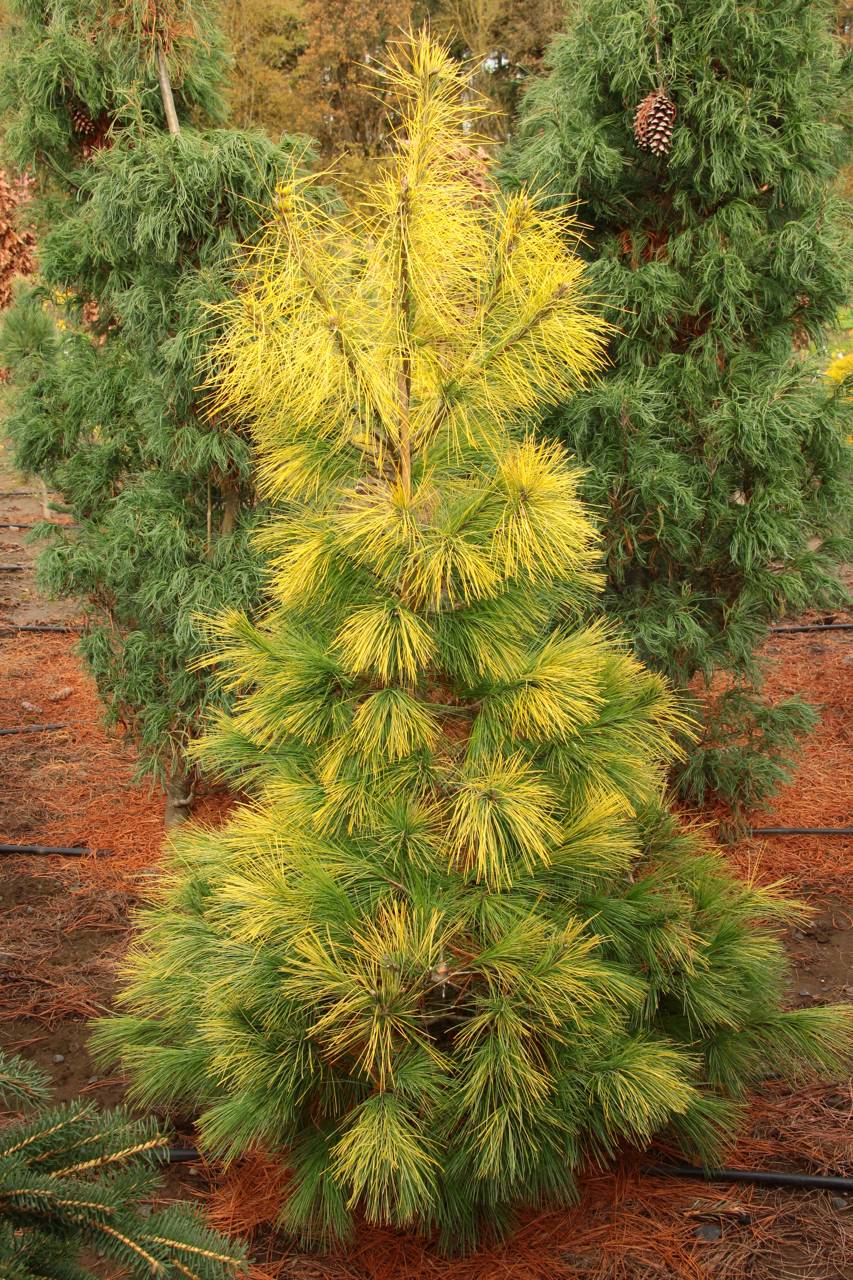
Kohout’s Ice Breaker Korean Fir
Abies koreana ‘Kohout’s Ice Breaker’Needle Color: White/Silver
Cone Color: Brown
This unique conifer began life as a witch’s broom, a common plant deformity, and is now a miniature specimen for landscapes and containers. The mature plant is less than 2’ tall, and is a dense, compact globe. New growth is tightly recurved, showing the white underside of the needles.
This cultivar is more tolerant of hot, dry conditions than most other firs.
Plant Profile:
- Height @ 10 Years: 1.5’
- Width @ 10 Years: 1’
- Hardiness Zone: 5-8
- Sun Exposure: Sun
- Soil Preference: Sandy-loamy, moist-dry, well-drained, slightly acidic
-
Pest Resistance:
- Deer
- Essentially disease-free
-
Pest Vulnerability:
- Aphids
- Adelgids
- Container Plant: Yes
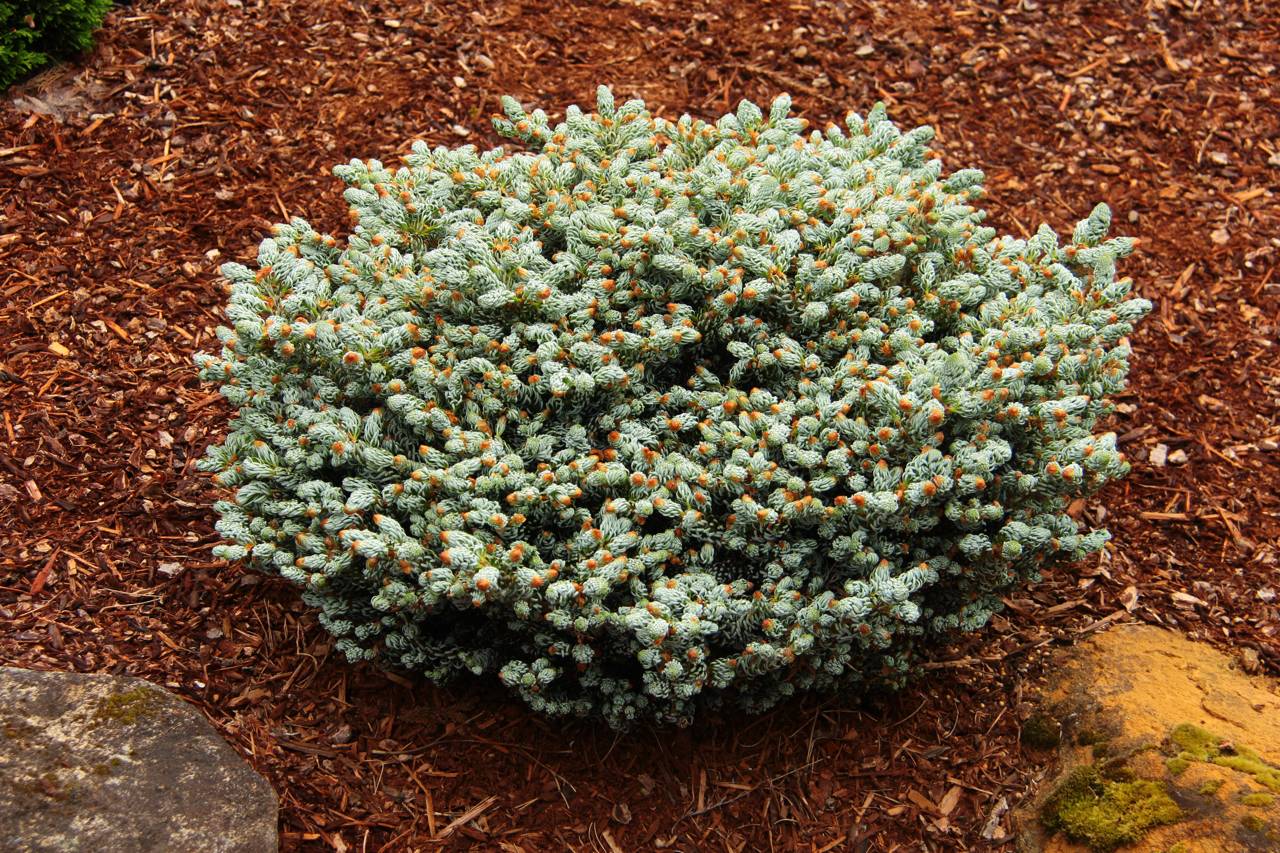
Blue Surprise Lawson False Cypress
Chamaecyparis lawsoniana ‘Blue Surprise’Needle Color: Blue/Purple
Cone Color: Blue/Brown
This bright blue false cypress has a tight, upright, columnar form. The branches are thin, delicate, and dense, which gives the plant a soft, formal appearance. During the winter, this small tree fades to a blue/purple color.
This false cypress is drought tolerant and pollution tolerant.
Plant Profile:
- Height @ 10 Years: 5’
- Width @ 10 Years: 1.5’
- Hardiness Zone: 5-8
- Sun Exposure: Sun
- Soil Preference: Rich-sandy, moist-dry, well-drained, slightly acidic
-
Pest Resistance:
- Deer
- Verticillium wilt
-
Pest Vulnerability:
- Nothing of significance
- Container Plant: Yes
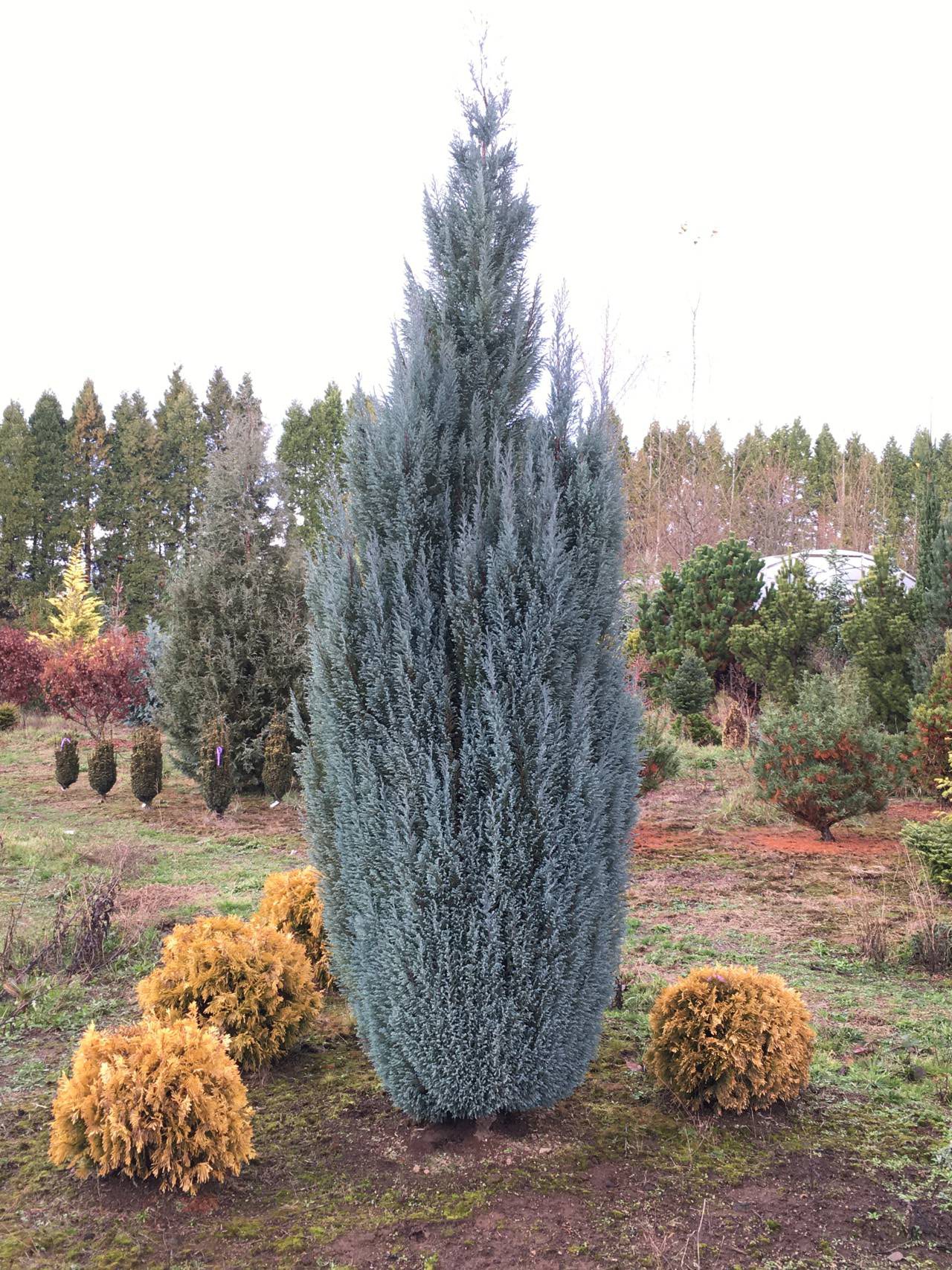
Carsten’s Wintergold Mugo Pine
Pinus mugo ‘Carsten’s Wintergold’Needle Color: Gold
Cone Color: Brown
This compact, bushy mugo pine has a rich orange/gold color during the fall and winter seasons. This pine has incredible cold tolerance, and as temperatures drop, the color intensifies. This specimen plant is perfect for small landscapes or containers.
This pine is drought resistant.
Plant Profile:
- Height @ 10 Years: .75’
- Width @ 10 Years: 2’
- Hardiness Zone: 2-8
- Sun Exposure: Sun
- Soil Preference: Rich-sandy, moist-dry, well-drained, slightly acidic-slightly alkaline
-
Pest Resistance:
- Deer
-
Pest Vulnerability:
- Aphids
- Adelgids
- Sawflies
- Pine shoot moth
- Container Plant: No
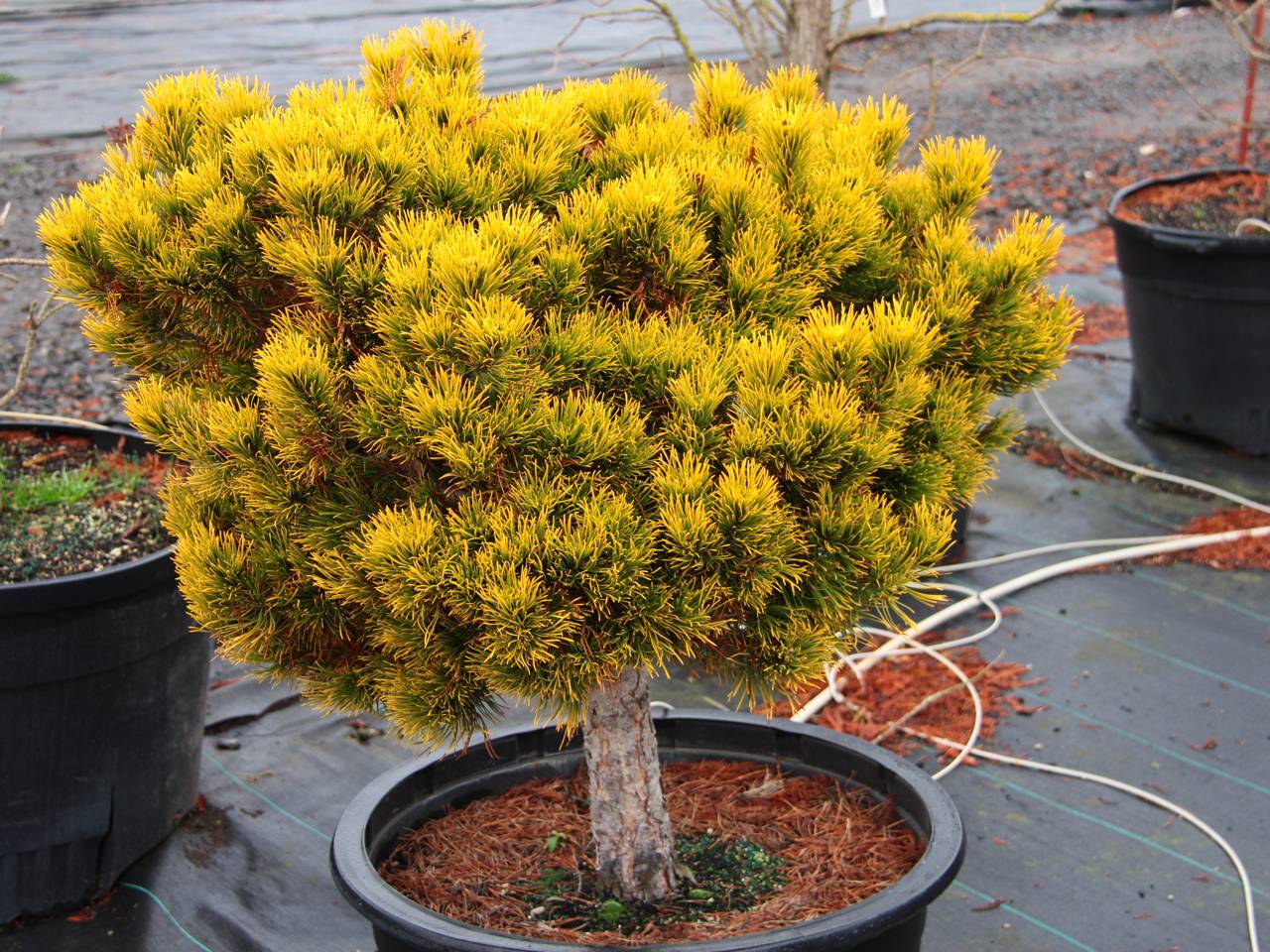
Conifers for Spring Color
These conifers produce bright new growth in the spring that stands in sharp contrast to the mature needles. Most of the conifers on this list will have a more noticeable color display if they are planted in part shade.
Prune (link to pruning page) these conifers to create dense outer growth, which will produce a more spectacular display in the spring.
Taylor’s Sunburst Lodgepole Pine
Pinus contorta var. latifolia ‘Taylor’s Sunburst’Needle Color: Yellow
Cone Color: Brown
This upright dwarf tree has bright yellow candles each spring, which stand in stark contrast to the mature, deep-green needles from the year before. This pine is more columnar than a pyramid, but more pyramidal than a column, placing it firmly in a unique form category. Branches curve upwards at the tips, and in the spring, it almost looks like the tree is a flaming candelabra.
This pine is drought resistant.
Plant Profile:
- Height @ 10 Years: 5’
- Width @ 10 Years: 2’
- Hardiness Zone: 5-8
- Sun Exposure: Sun/Part Sun
- Soil Preference: Rich-sandy, moist-dry, well-drained, slightly acidic
-
Pest Resistance:
- Deer
- Verticillium wilt
-
Pest Vulnerability:
- Nothing significant
- Container Plant: No
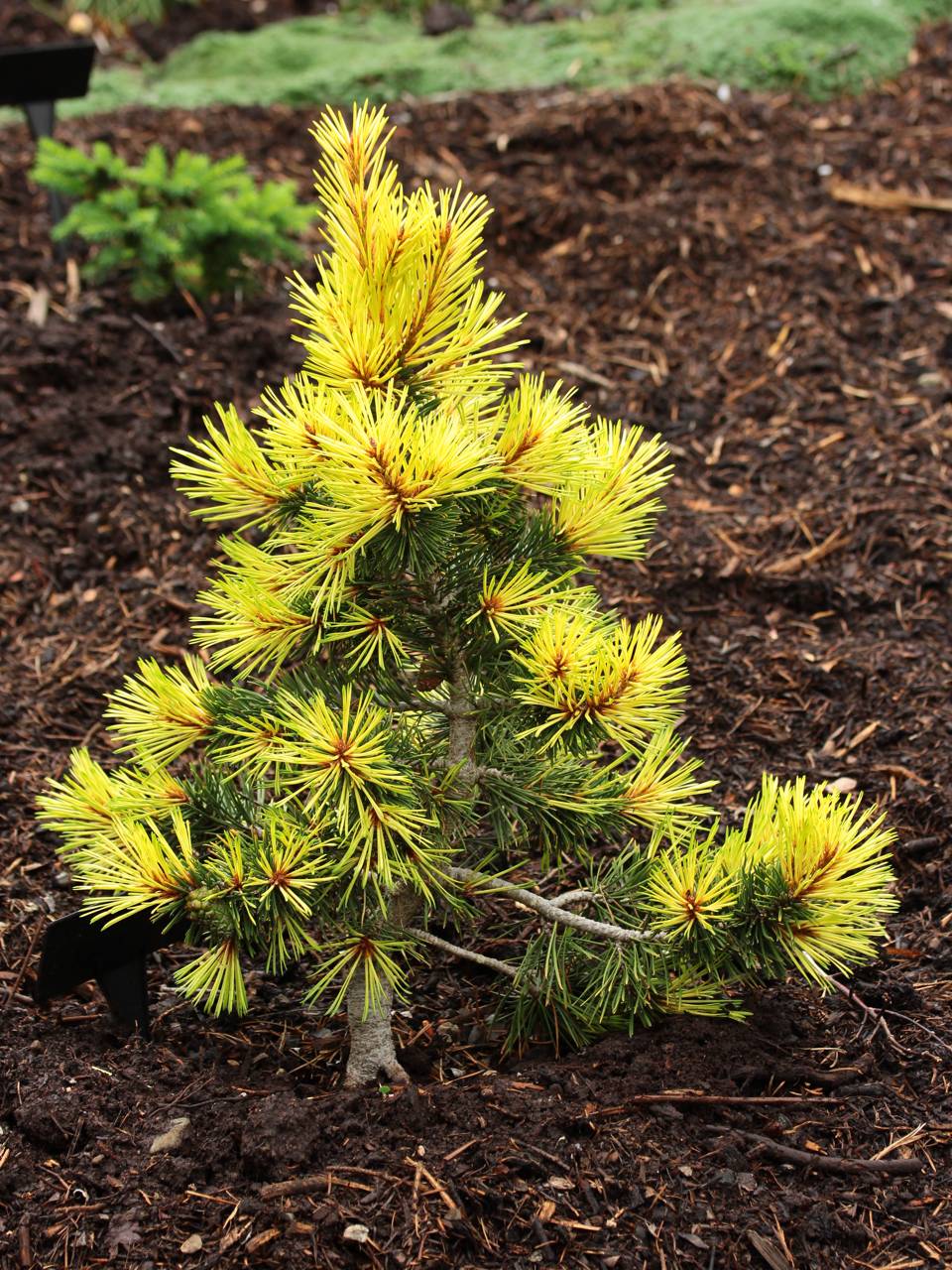
Brentmoor Blonde Scots Pine
Pinus sylvestris ‘Brentmoor Blonde’Needle Color: Cream
Cone Color: Brown
This rare Scots pine has an almost frosted appearance during the spring as new needles emerge. As one of the only pines with white foliage, this dwarf specimen tree is difficult to find, but makes a spectacular addition to any landscape.
Plant Profile:
- Height @ 10 Years: 8.5’
- Width @ 10 Years: 6’
- Hardiness Zone: 3-8
- Sun Exposure: Part Sun
- Soil Preference: Rich, moist-dry, well-drained, slightly acidic
-
Pest Resistance:
- Deer
- Verticillium wilt
-
Pest Vulnerability:
- Nothing significant
- Container Plant: No
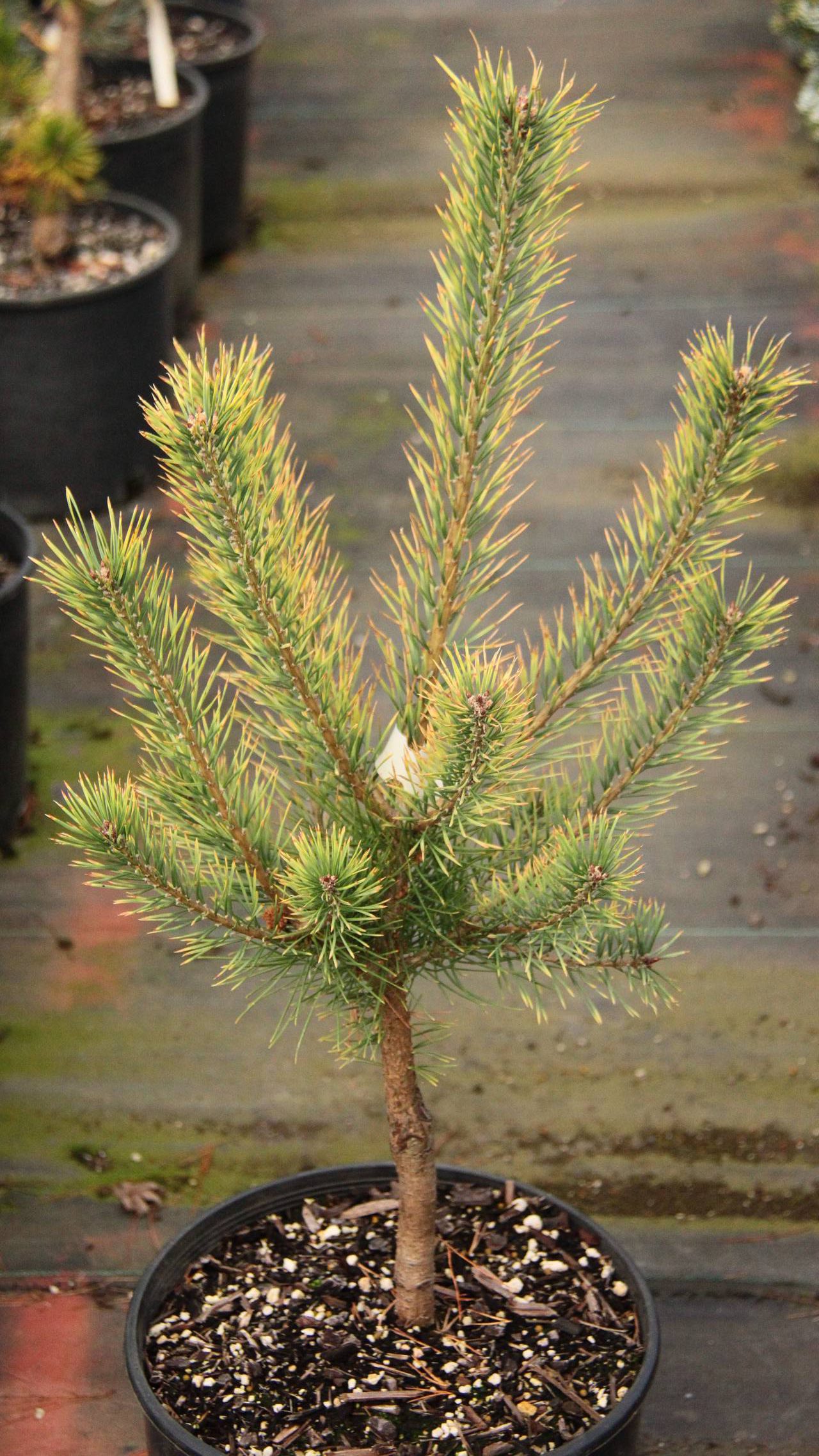
Perry’s Gold Norway Spruce
Picea abies ‘Perry’s Gold’Needle Color: Gold
Cone Color: Brown
This unique cultivar of Norway Spruce is an excellent specimen plant for part shade. The bright yellow burst of growth each spring makes the tree look like it grew its own Christmas lights. The color will eventually fade to a deep green, but this perky spruce still makes a statement during the summer with a fun, whimsical form.
The delicate, golden needles may burn in full sun.
Plant Profile:
- Height @ 10 Years: 4’
- Width @ 10 Years: 2’
- Hardiness Zone: 2-8
- Sun Exposure: Part Sun
- Soil Preference: Rich, moist-dry, well-drained, slightly acidic
-
Pest Resistance:
- Deer
- Verticillium wilt
-
Pest Vulnerability:
- Nothing significant
- Container Plant: Yes
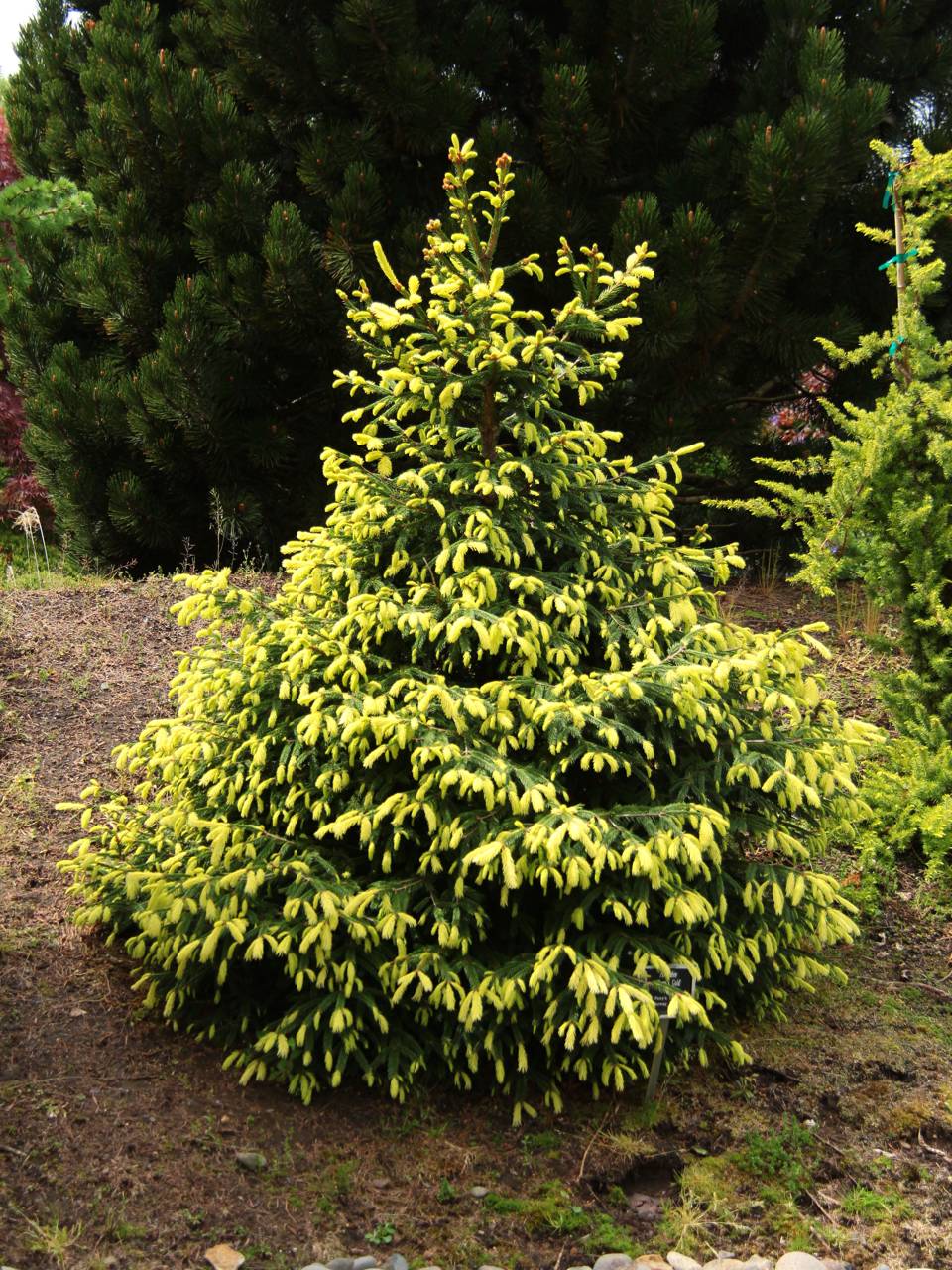
Pusch Norway Spruce
Picea abies ‘Pusch’
Needle Color: Green
Cone Color: Red
This dwarf conifer was propagated from a witch’s broom on an Acrocona Norway spruce. Like the Acrocona, the Pusch cultivar has raspberry-red cones during the spring. The major difference between these two cultivars is the size. The Pusch Norway spruce maintains a very small, compact globe form through maturity.
This conifer is drought, wind, and pollution tolerant.
Plant Profile:
- Height @ 10 Years: 1’
- Width @ 10 Years: 2’
- Hardiness Zone: 4-8
- Sun Exposure: Sun/Part Sun
- Soil Preference: Rich-sandy, moist-dry, well-drained, slightly acidic
-
Pest Resistance:
- Deer
- Rabbit
-
Pest Vulnerability:
- Aphids
- Adelgids
- Conifer red spider mite
- Container Plant: No
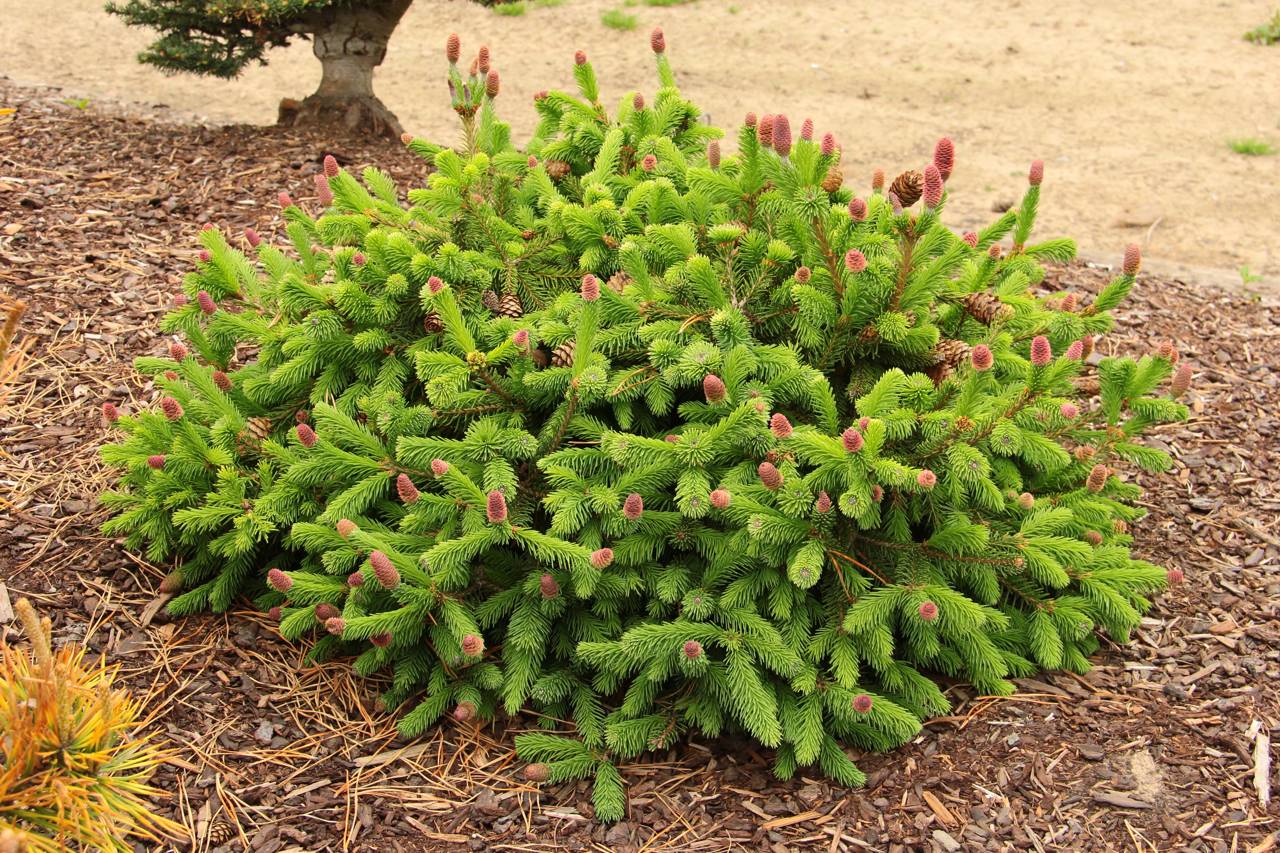
McConnell’s Gold White Spruce
Picea glauca ‘McConnell’s Gold’Needle Color: Gold
Cone Color: Brown
This frosty golden specimen tree is one of the first to break buds in the spring with a burst of soft yellow needles. This dwarf conifer has a strong pyramidal form with dense, deep green mature needles. The gold white spruce tolerates harsh winters and part shade, making it the perfect choice for northern landscapes.
This conifer is mildly resistant to pollution, but should be planted in a sheltered area of the landscape. Under ideal conditions, this conifer can last 50+ years.
Plant Profile:
- Height @ 10 Years: 4’
- Width @ 10 Years: 2’
- Hardiness Zone: 2-8
- Sun Exposure: Sun/Part Sun
- Soil Preference: Rich, moist-dry, well-drained, acidic
-
Pest Resistance:
- Deer
- Rabbit
-
Pest Vulnerability:
- Nothing significant
- Container Plant: No
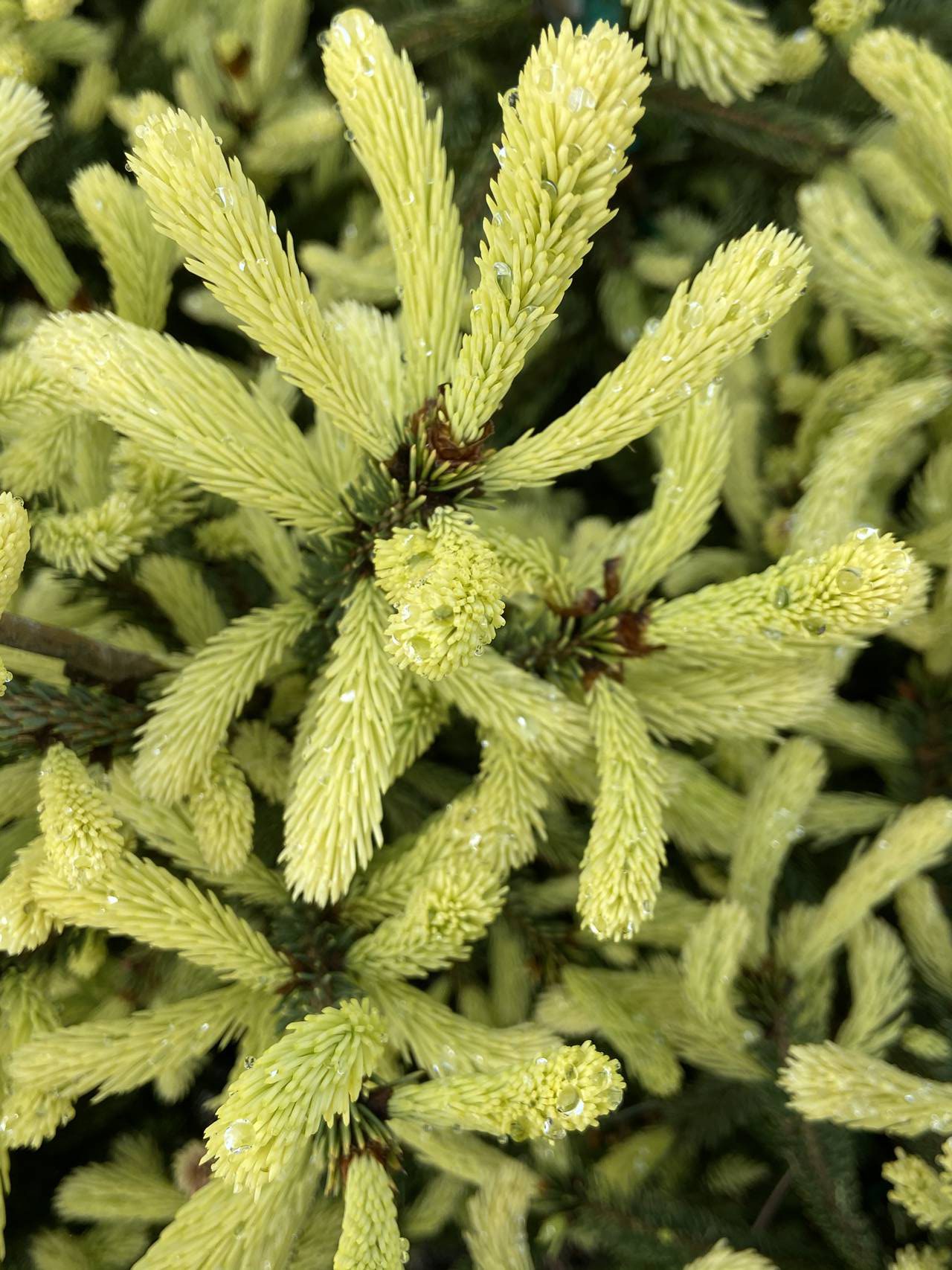
Golden Spring Colorado Spruce
Picea pungens ‘Bialobok’Needle Color: Gold
Cone Color: Brown
This elegant, feathery spruce has a traditional deep blue color, but during the spring, creamy golden new growth creates a delicate, colorful contrast. This tree has a looser form than other Colorado spruce cultivars, but its slightly droopy nature adds personality to any landscape.
This spruce is drought, salt, and pollution resistant.
Plant Profile:
- Height @ 10 Years: 5’
- Width @ 10 Years: 3’
- Hardiness Zone: 3-8
- Sun Exposure: Sun
- Soil Preference: Rich-sandy, moist-dry, well-drained, slightly acidic
-
Pest Resistance:
- Deer
- Rabbit
- Verticillium wilt
-
Pest Vulnerability:
- Aphids
- Adelgids
- Conifer red spider mite
- Container Plant: No
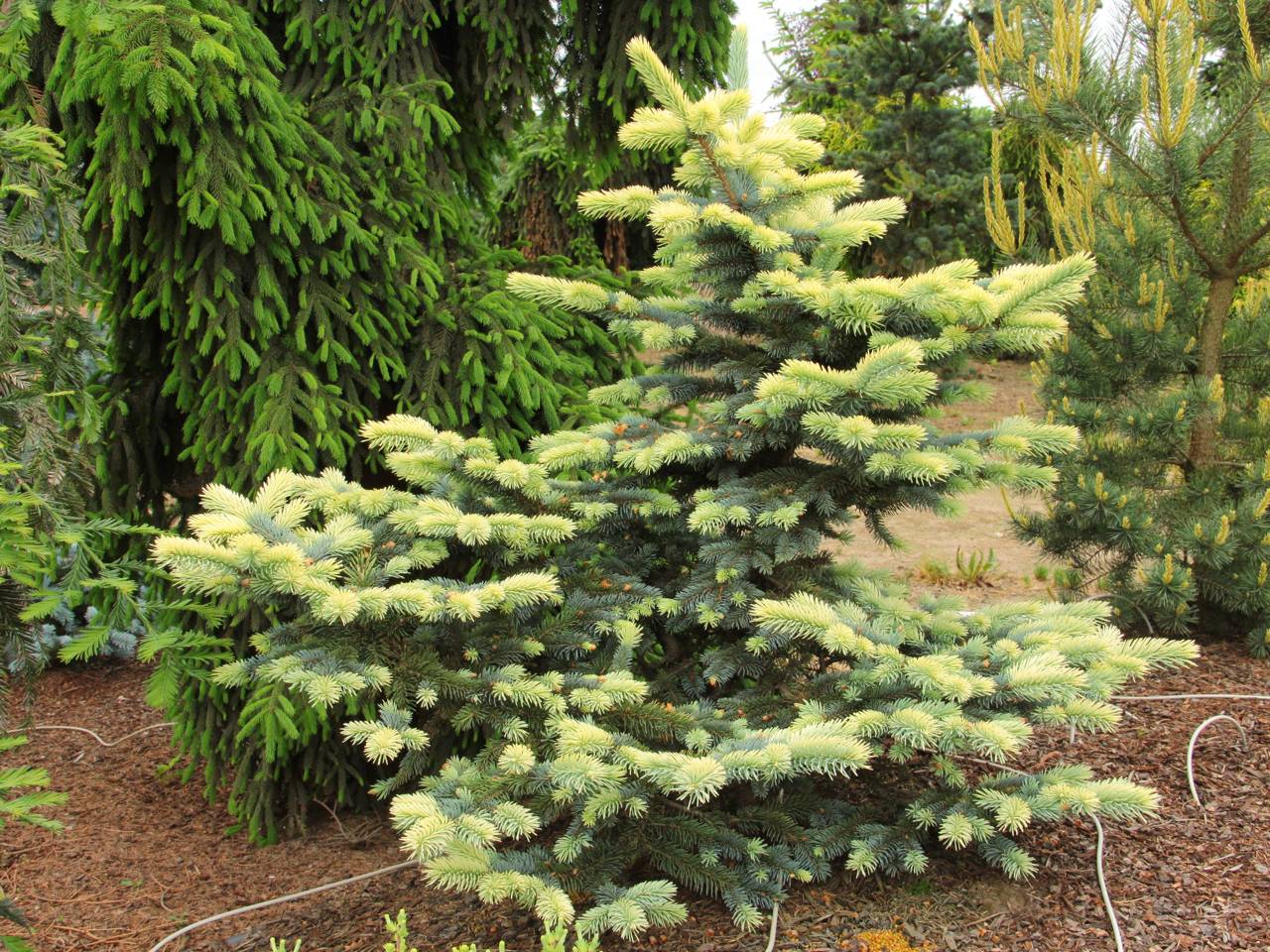
Ruby Teardrops Colorado Spruce
Picea pungens ‘Ruby Teardrops’Needle Color: Blue
Cone Color: Red
This dwarf Colorado spruce sports hundreds of bright red cones for over 2 months each spring. The cones emerge pink and quickly deepen into a sharp red, before eventually maturing into a brown color during the summer. The needles on the Ruby Red Colorado spruce are a richer blue than most other cultivars, making this a popular landscape specimen.
This tree does well in poor, rocky soils.
Plant Profile:
- Height @ 10 Years: 2’
- Width @ 10 Years: 3’
- Hardiness Zone: 4-8
- Sun Exposure: Sun
- Soil Preference: Rocky, moist-dry, well-drained, slightly acidic
-
Pest Resistance:
- Deer
- Rabbit
- Verticillium wilt
-
Pest Vulnerability:
- Nothing significant
- Container Plant: Yes
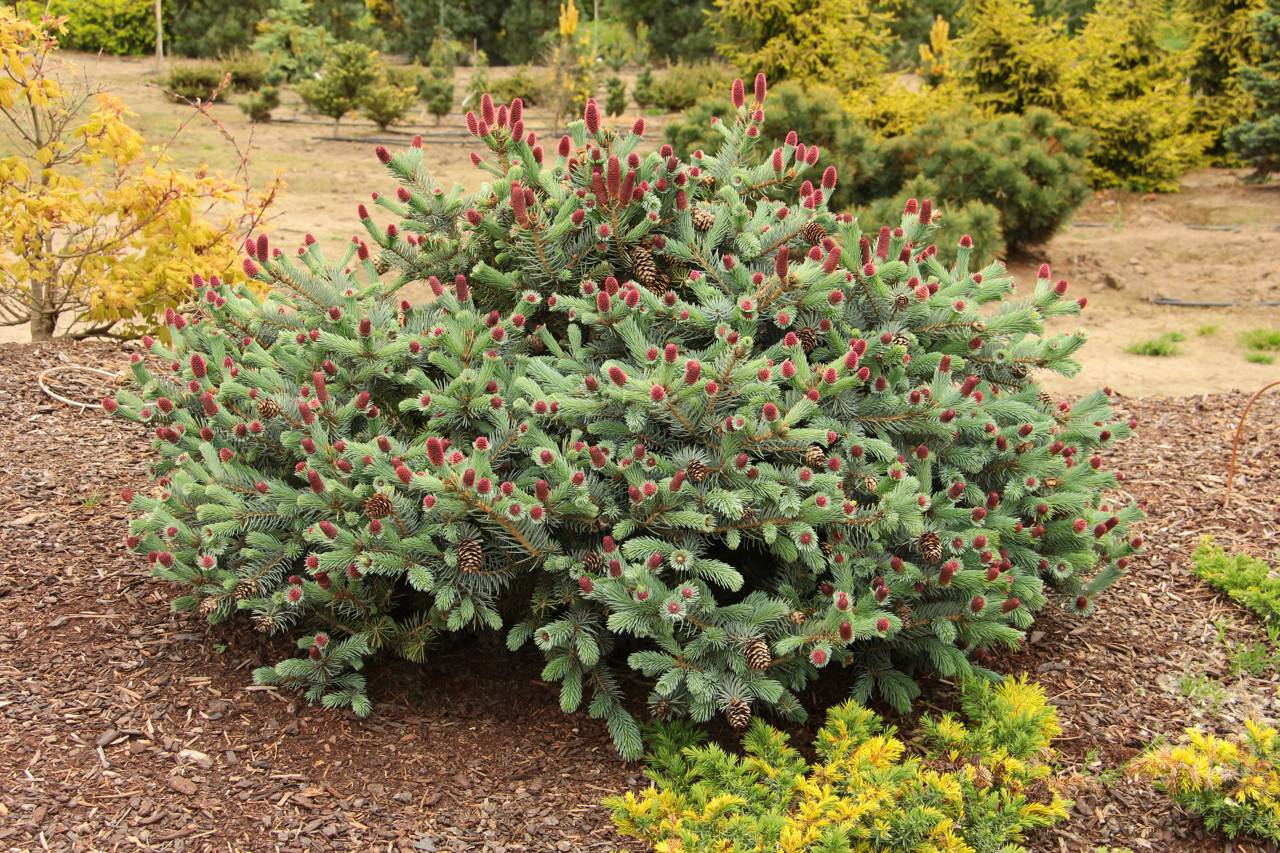
Deep Cove Himalayan Cedar
Cedrus deodara ‘Deep Cove’Needle Color: Silver
Cone Color: Brown
This magical tree has deep blue needles, but in the spring, the new silver growth makes it look like it has a light dusting of snow. This cultivar has a slightly droopy, whimsical form, and is a striking specimen tree in lawns or landscapes. This tree does not perform well in containers.
This cedar is wind and drought tolerant.
Plant Profile:
- Height @ 10 Years: 7’
- Width @ 10 Years: 5’
- Hardiness Zone: 6-9
- Sun Exposure: Sun
- Soil Preference: Rich, moist-dry, well-drained, slightly acidic
-
Pest Resistance:
- Deer
- Rabbit
-
Pest Vulnerability:
- Canker
- Weevil
- Container Plant: No
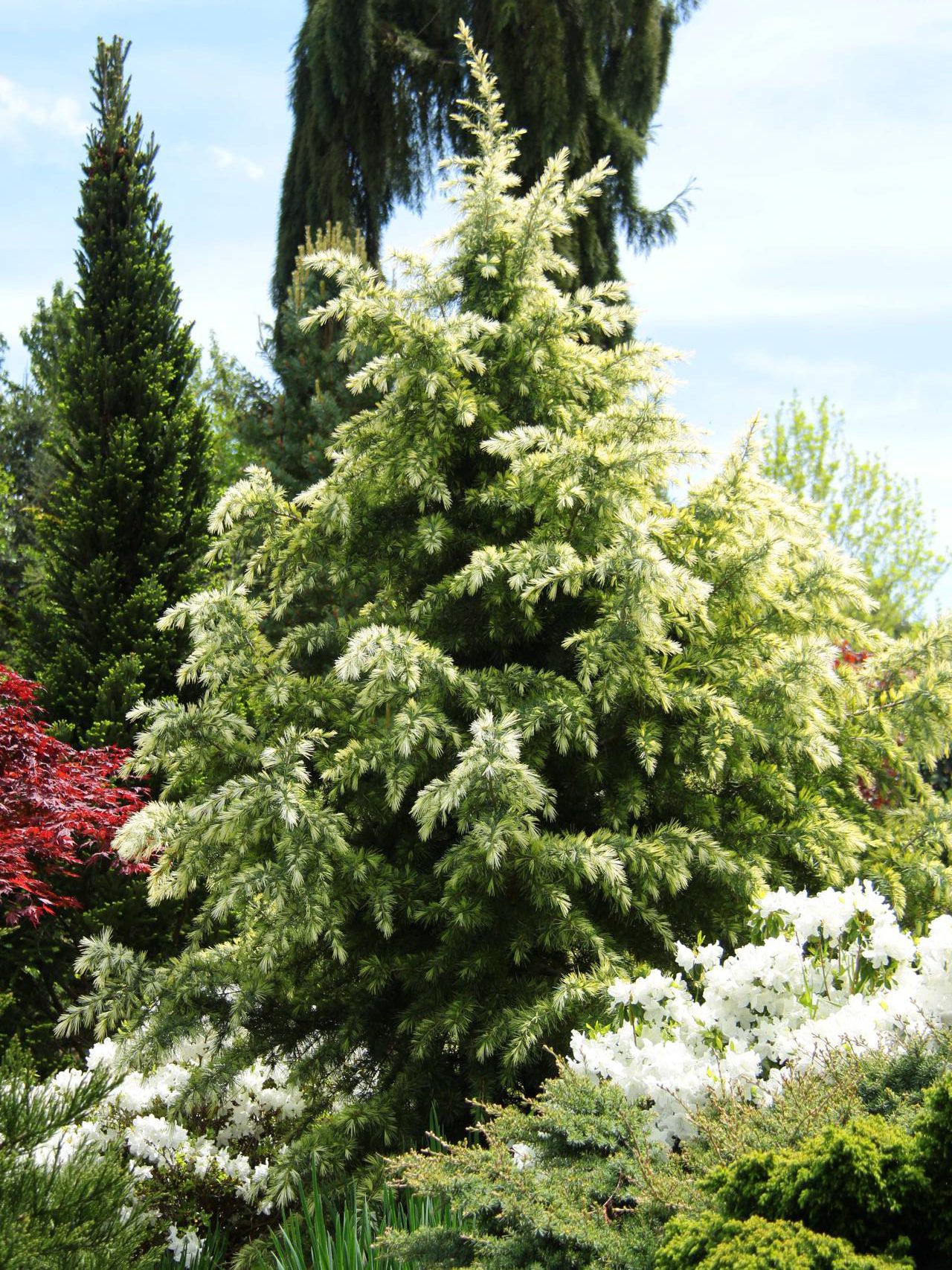
Conifers with Showy Cones
Conifers in this category will produce colorful or uniquely-shaped cones in the spring. These conifers are good specimens for the more accessible parts of a landscape so the cones can be viewed and admired.
Once the cones begin to mature, they will all turn into a reddish brown or dark brown color.
Consistent pruning (link to pruning page) can help increase cone production.
Pusch Norway Spruce
Picea abies ‘Pusch’Needle Color: Green
Cone Color: Red
This dwarf conifer was propagated from a witch’s broom on an Acrocona Norway spruce. Like the Acrocona, the Pusch cultivar has raspberry-red cones during the spring. The major difference between these two cultivars is the size. The Pusch Norway spruce maintains a very small, compact globe form through maturity.
This conifer is drought, wind, and pollution tolerant.
Plant Profile:
- Height @ 10 Years: 1’
- Width @ 10 Years: 2’
- Hardiness Zone: 4-8
- Sun Exposure: Sun/Part Sun
- Soil Preference: Loamy-sandy, moist-dry, well-drained, slightly acidic
-
Pest Resistance:
- Deer
- Rabbit
-
Pest Vulnerability:
- Aphids
- Adelgids
- Conifer red spider mite
- Container Plant: No
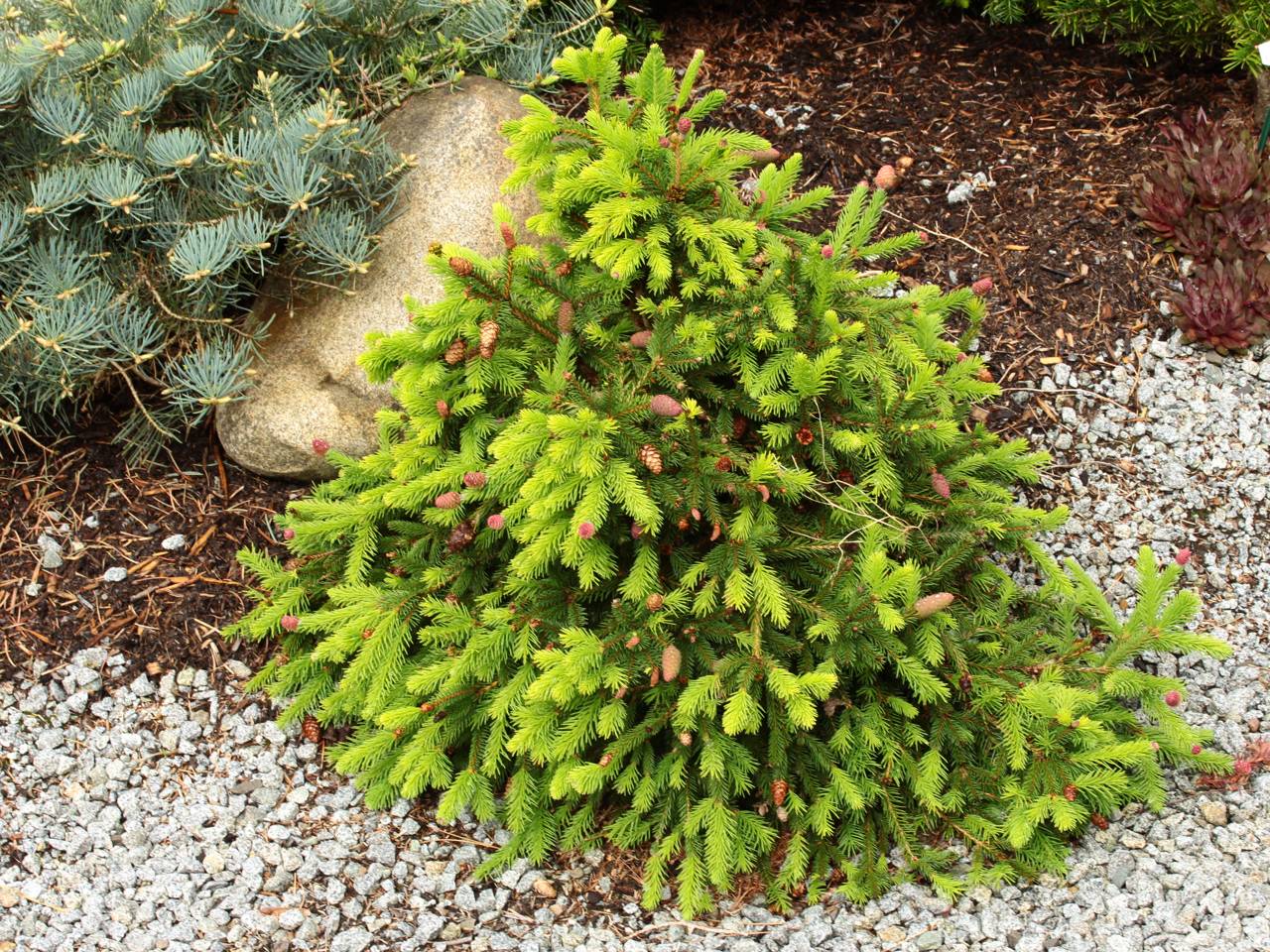
Ruby Teardrops Colorado Spruce
Picea pungens ‘Ruby Teardrops’Needle Color: Blue
Cone Color: Red
This dwarf Colorado spruce sports hundreds of bright red cones for over 2 months each spring. The cones emerge pink and quickly deepen into a sharp red, before eventually maturing into a brown color during the summer. The needles on the Ruby Red Colorado spruce are a richer blue than most other cultivars, making this a popular landscape specimen.
This tree does well in poor, rocky soils.
Plant Profile:
- Height @ 10 Years: 2’
- Width @ 10 Years: 3’
- Hardiness Zone: 4-8
- Sun Exposure: Sun
- Soil Preference: Rocky, moist-dry, well-drained, slightly acidic
-
Pest Resistance:
- Deer
- Rabbit
- Verticillium wilt
-
Pest Vulnerability:
- Nothing significant
- Container Plant: Yes
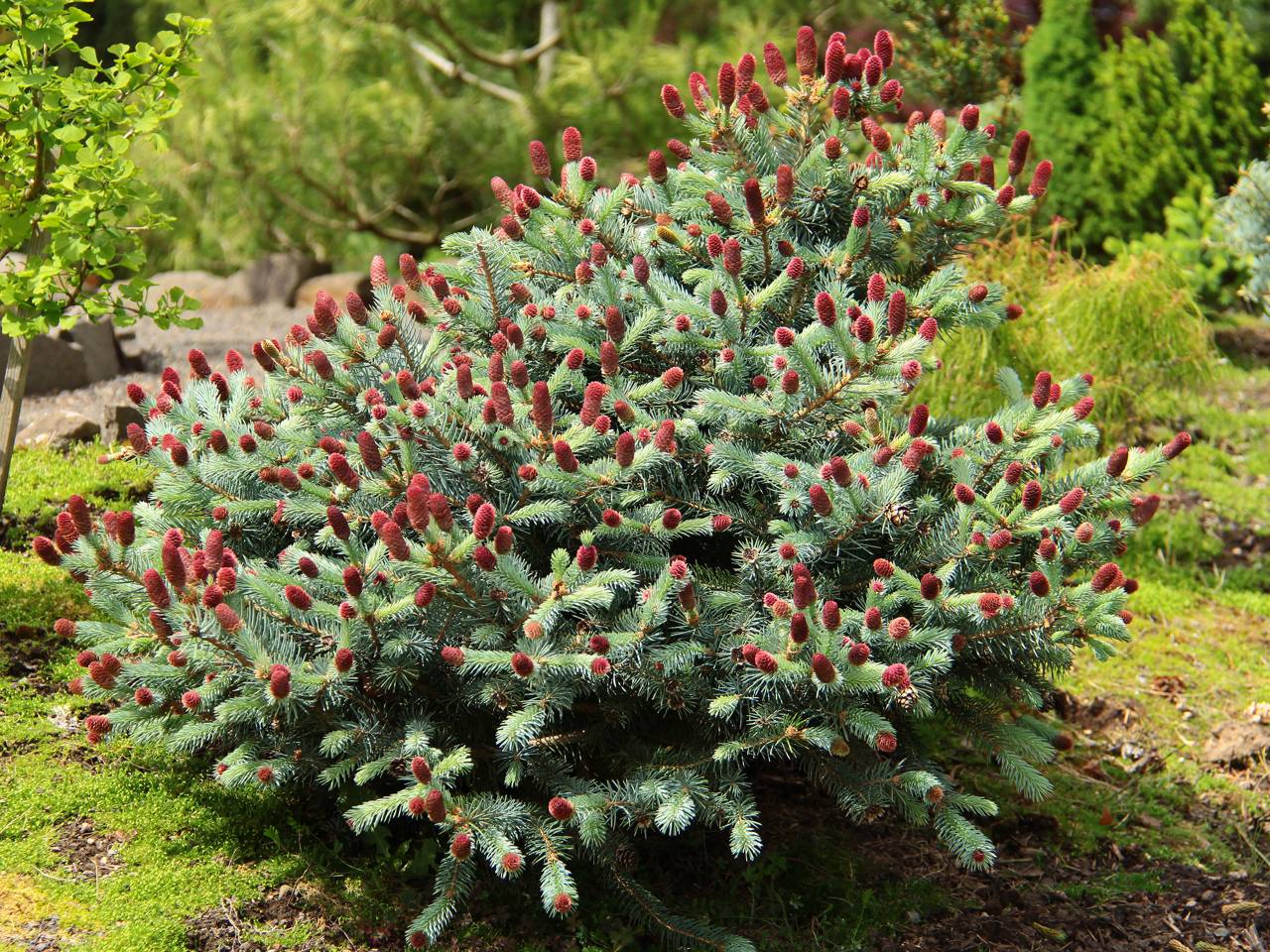
Silberlocke Korean Fir
Abies koreana ‘Horstmann’s Silberlocke’Needle Color: Silver
Cone Color: Purple
This beautiful silver evergreen provides strong contrast in a landscape. Needles are tightly recurved, which gives the tree a firm, pyramidal shape. Upright, deep-purple cones provide seasonal, structural interest.
This conifer is considered to be low-maintenance and tolerates most soil and light conditions.
Plant Profile:
- Height @ 10 Years: 6’
- Width @ 10 Years: 3’
- Hardiness Zone: 5-8
- Sun Exposure: Sun/Part Shade
- Soil Preference: Rich, moist, well-drained, slightly acidic
-
Pest Resistance:
- Essentially disease-free
- Deer
-
Pest Vulnerability:
- Aphids
- Adelgids
- Container Plant: No
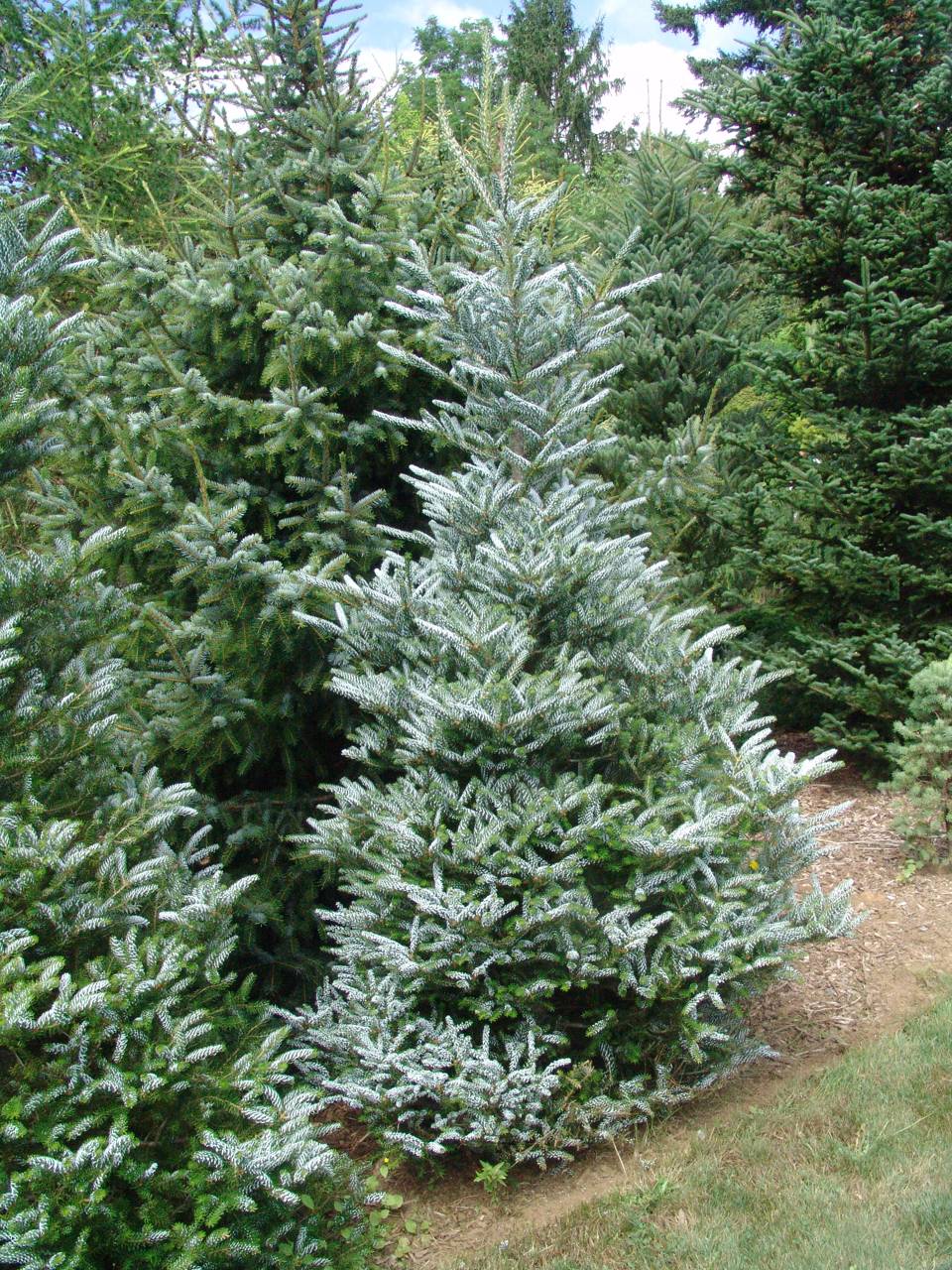
Blue Compact Subalpine Fir
Abies lasiocarpa ‘Glauca Compacta’Needle Color: Light Blue
Cone Color: Purple
This little conifer is true to its name. The tree is a dense, compact pyramid with upright branches. The frosted, light-blue needles provide year-round interest, but the true focal point of this conifer is the bright purple cones that appear in the spring.
Plant Profile:
- Height @ 10 Years: 3’
- Width @ 10 Years: 1.5’
- Hardiness Zone: 4-8
- Sun Exposure: Sun/Part Shade
- Soil Preference: Sandy, well-drained, slightly acidic
-
Pest Resistance:
- Essentially disease-free
- Deer
-
Pest Vulnerability:
- Nothing significant
- Container Plant: Yes
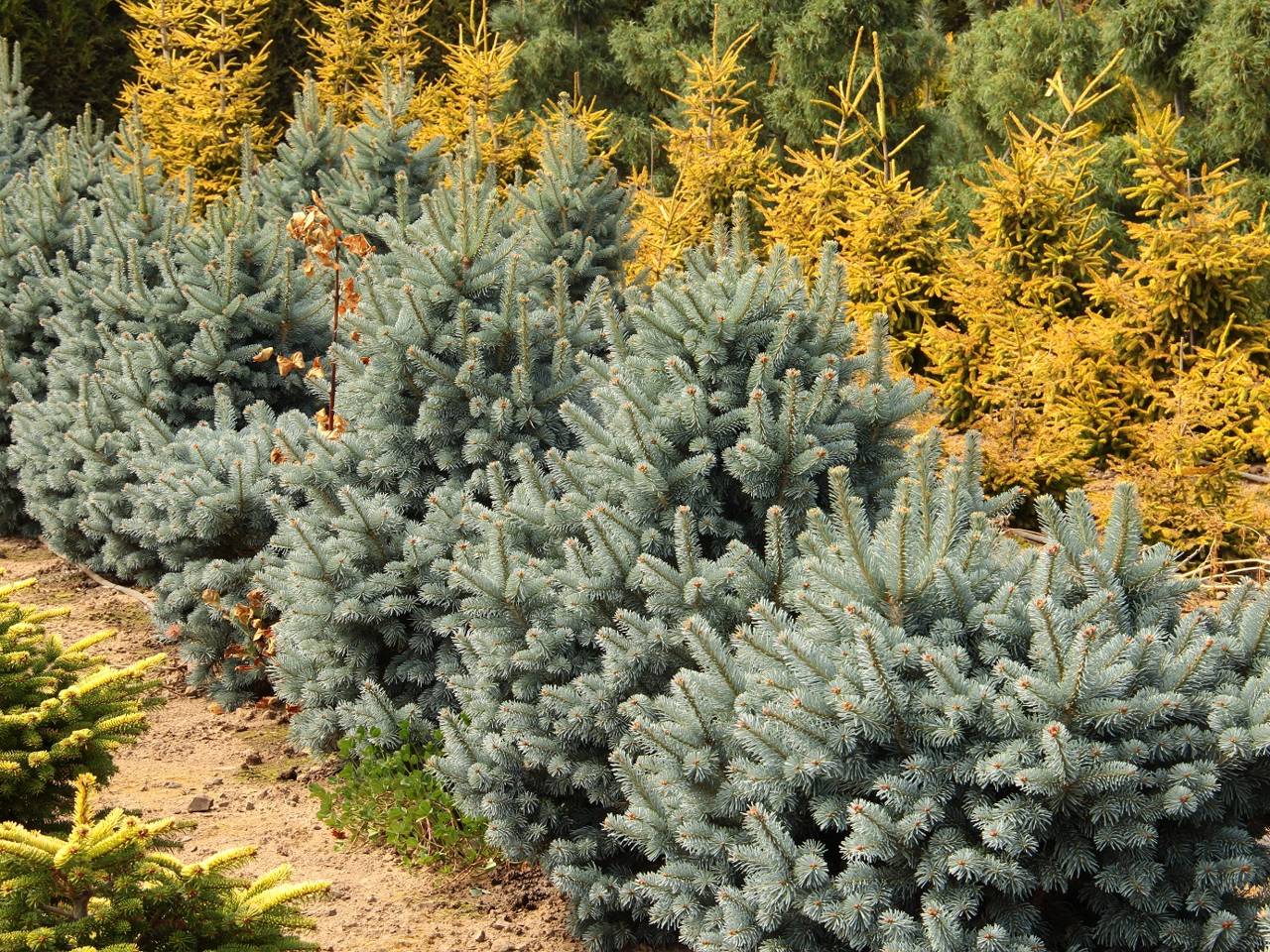
Coney Island Eastern White Pine
Pinus strobus ‘Coney Island’Needle Color: Blue/Green
Cone Color: Brown
This dwarf pine has long, brown cones hanging from the branches that resemble hot dogs. Although the color isn’t spectacular, the cones are conspicuous because they are conspicuous compared to the small size of the mature plant. This is another variety that was cultivated from a witch’s broom, and it will retain a small, globose shape into maturity.
This pine is drought tolerant.
Plant Profile:
- Height @ 10 Years: 2.5’
- Width @ 10 Years: 3’
- Hardiness Zone: 3-8
- Sun Exposure: Sun
- Soil Preference: Sandy, well-drained, slightly acidic
-
Pest Resistance:
- Essentially disease-free
- Deer
-
Pest Vulnerability:
- Aphids
- Adelgids
- Container Plant: Yes
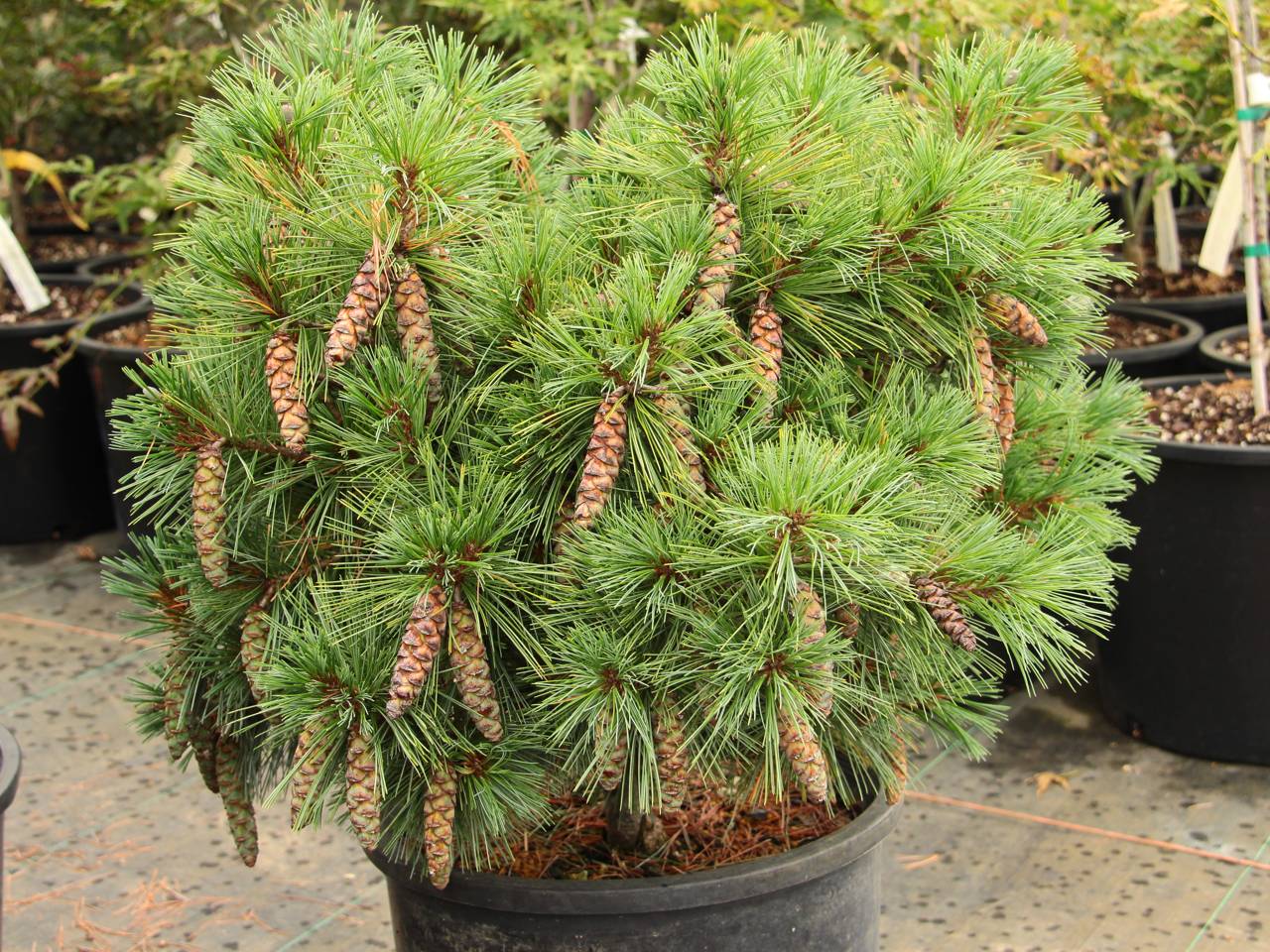
Weithorst Hybrid Pine
Pinus schwerinii (x) ‘Wiethorst’Needle Color: Blue/Green
Cone Color: Brown
This hybrid pine is another conifer that began life as a witch’s broom. The long, delicate needles are soft and loose, but the plant can become quite dense if it is pruned regularly. This conifer produces an abundance of long, blue cones that eventually mature to a deep brown color.
This pine is drought resistant.
Plant Profile:
- Height @ 10 Years: 5’
- Width @ 10 Years: 3’
- Hardiness Zone: 4-8
- Sun Exposure: Sun
- Soil Preference: Sandy-rich, well-drained, slightly acidic
-
Pest Resistance:
- Essentially disease-free
- Deer
-
Pest Vulnerability:
- Aphids
- Adelgids
- Container Plant: No
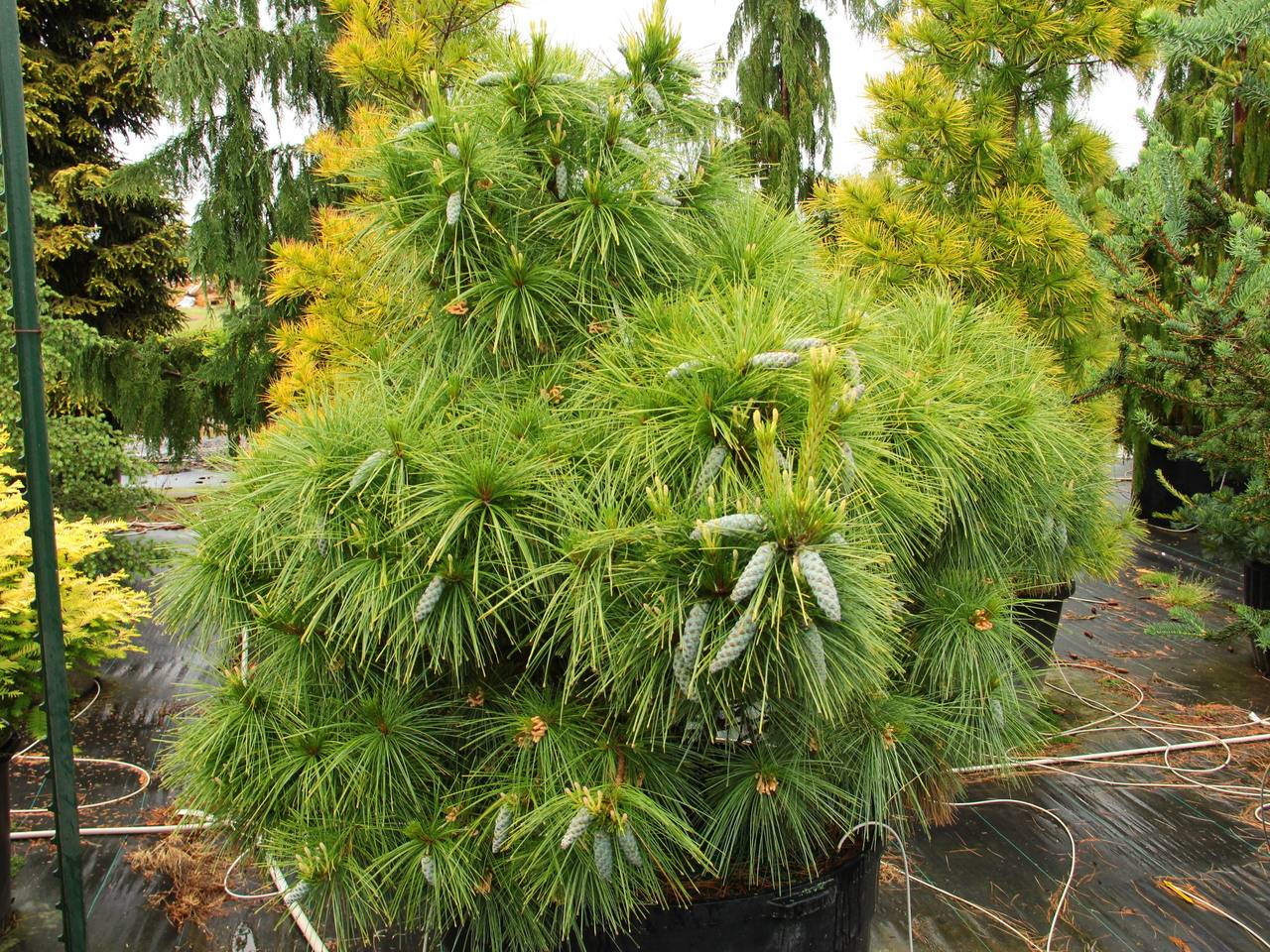
Weeping Conifers
Weeping conifers commonly earn the nickname “Dr. Seuss tree” from loving homeowners. Their floppy, droopy, sporadic growth habit adds a humorous element to many landscapes.
Of course, some weeping conifers have a truly elegant look to them. These conifers are more symmetrical and even, but the limbs are flexible and create a soft, layered look.
Either way, weeping conifers are an amazing specimen plant for a landscape or container garden.
Weeping White Spruce
Picea glauca ‘Pendula’Needle Color: Green
Cone Color: Brown
This weeping conifer has a tall, lanky look with pillowy, layered branches. The mature tree has a tight, columnar form with a pointed top. This plant can be grown almost everywhere except the extreme lower portions of the United States.
This conifer is an excellent selection for a bird garden.
Plant Profile:
- Height @ 10 Years: 9’
- Width @ 10 Years: 3’
- Hardiness Zone: 2-8
- Sun Exposure: Sun
- Soil Preference: Sandy-rich, well-drained, slightly acidic
-
Pest Resistance:
- Essentially disease-free
- Deer
-
Pest Vulnerability:
- Aphids
- Adelgids
- Conifer red spider mite
- Container Plant: No
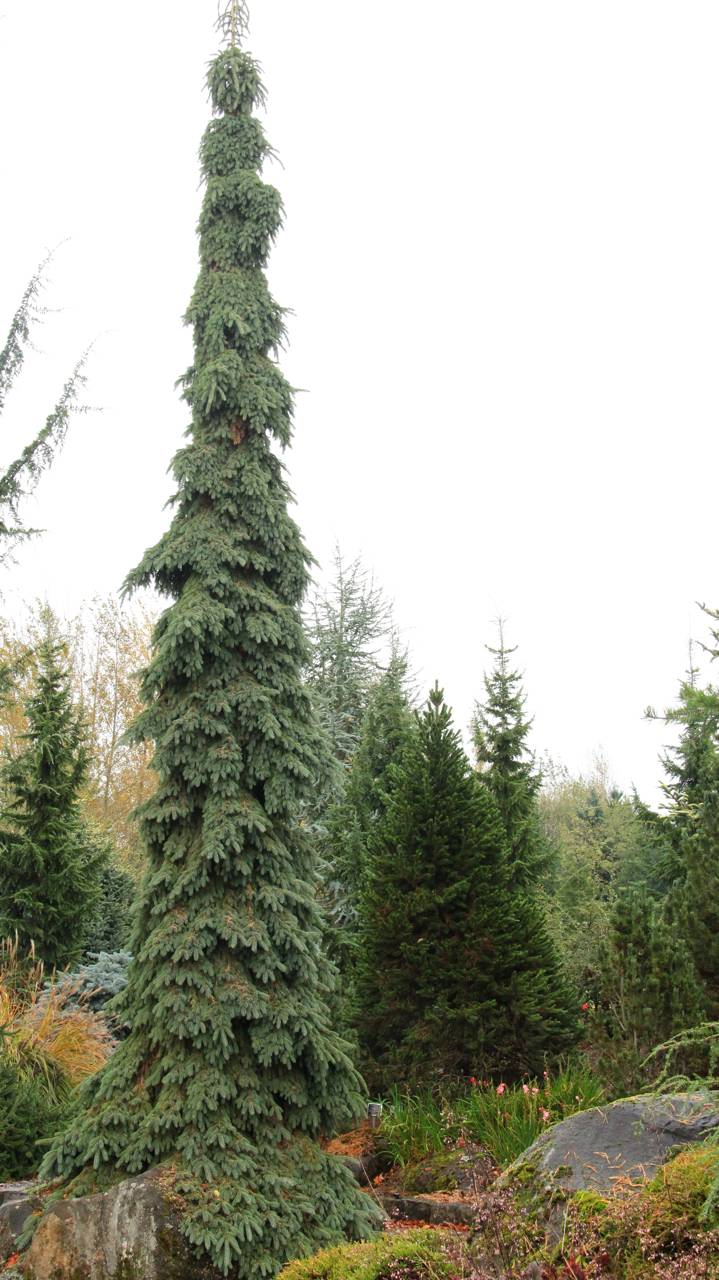
Gold Drift Norway Spruce
Picea abies ‘Gold Drift’Needle Color: Gold
Cone Color: Red
This droopy tree has a deep green foliage that fades into a bright gold color. As the tree matures, the top will fall over, giving the tree a humorous character. Although the tree has a general weeping habit, the branches can be sporadic.
You can also train this conifer up a stake to the desired height, then allow the top to fall over. This gives the tree a more elegant, graceful appearance.
Plant Profile:
- Height @ 10 Years: 6’
- Width @ 10 Years: 2’
- Hardiness Zone: 4-8
- Sun Exposure: Sun/Part Shade
- Soil Preference: Sandy-loamy, well-drained, slightly acidic
-
Pest Resistance:
- Essentially disease-free
- Deer
- Rabbit
-
Pest Vulnerability:
- Aphids
- Adelgids
- Conifer red spider mite
- Container Plant: No
.jpg)
Catherine’s Golden Heart Norway Spruce
Picea abies ‘Catherine’s Golden Heart’Needle Color: Green
Cone Color: Brown
This is a new cultivar with bright green needles and a slightly drooping form. Contrary to most weeping conifers, this small tree has a gentle, graceful appearance without being floppy. Combined with the golden undertones, this rare conifer is an excellent specimen for a landscape or large container.
Plant Profile:
- Height @ 10 Years: 3’
- Width @ 10 Years: 5’
- Hardiness Zone: 3-8
- Sun Exposure: Sun/Part Shade
- Soil Preference: Sandy-loamy, well-drained, slightly acidic
-
Pest Resistance:
- Verticillium wilt
- Deer
-
Pest Vulnerability:
- Nothing significant
- Container Plant: Yes
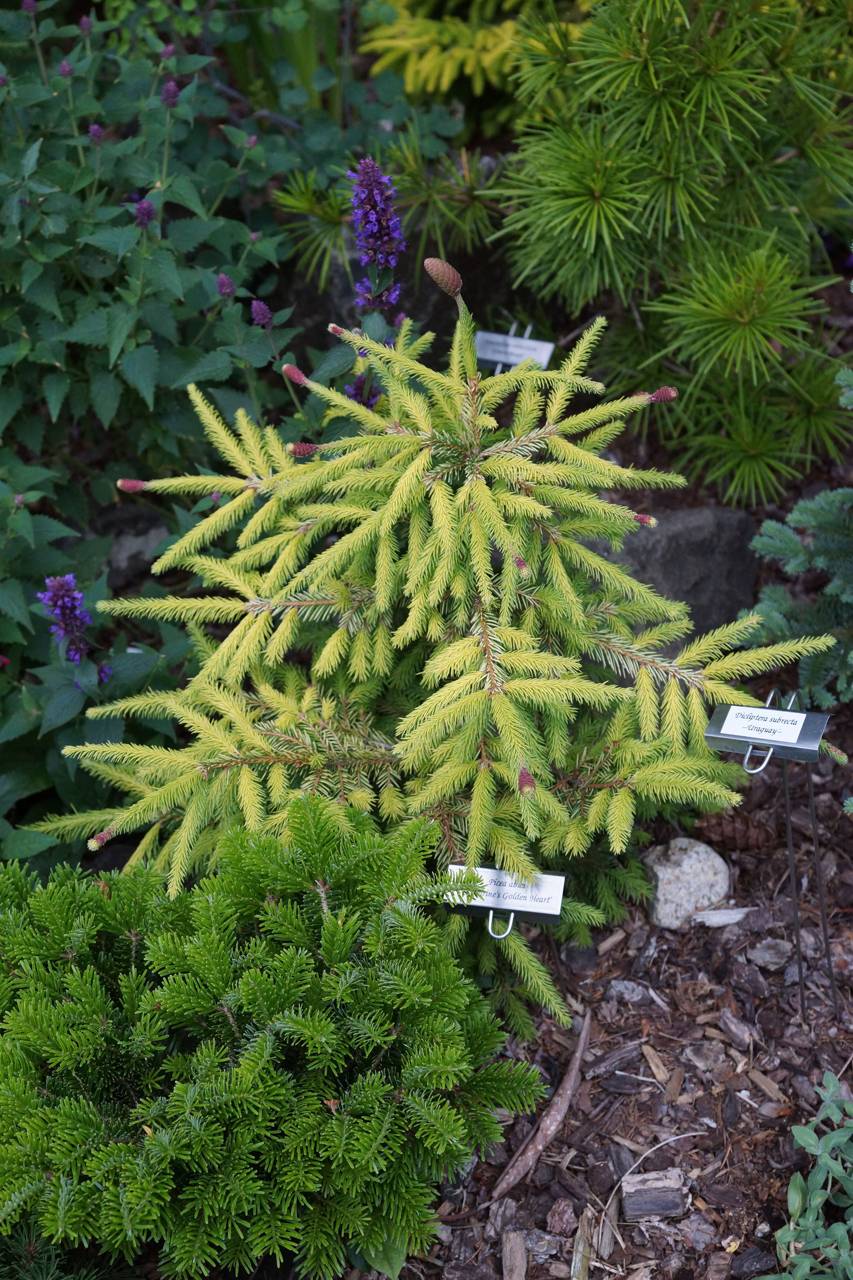
Blue Maltese Eastern White Pine
Pinus strobus ‘Blue Maltese’Needle Color: Green
Cone Color: Brown
This shaggy conifer has a unique, dense, fluffy appearance. Branches droop down over each other to create a carpet of bluish green needles. The mature tree has a long, thin, mounding appearance that is slightly pyramidal.
This conifer is drought resistant.
Plant Profile:
- Height @ 10 Years: 4’
- Width @ 10 Years: 5’
- Hardiness Zone: 3-8
- Sun Exposure: Sun
- Soil Preference: Sandy-loamy, well-drained, slightly acidic
-
Pest Resistance:
- Verticillium wilt
- Deer
-
Pest Vulnerability:
- Aphids
- Adelgids
- Container Plant: No
.jpg)
Feelin’ Sunny Himalayan Cedar
Cedrus deodara ‘Feelin’ Sunny’Needle Color: Yellow/Green
Cone Color: Brown
This bright conifer has a sporadic, horizontal growth pattern that resembles a splash of lime green water. Although the main branches tend to be strong and sturdy, new growth is quite flexible and droopy. New spring growth is a bright yellow or white color, which provides an incredible contrast with the weeping, mature growth.
This conifer is drought resistant.
Plant Profile:
- Height @ 10 Years: 2.5’
- Width @ 10 Years: 4.5’
- Hardiness Zone: 6-9
- Sun Exposure: Sun
- Soil Preference: Sandy-loamy, well-drained, slightly acidic-slightly alkaline
-
Pest Resistance:
- Essentially disease-free
- Deer
- Rabbit
-
Pest Vulnerability:
- Nothing significant
- Container Plant: Yes
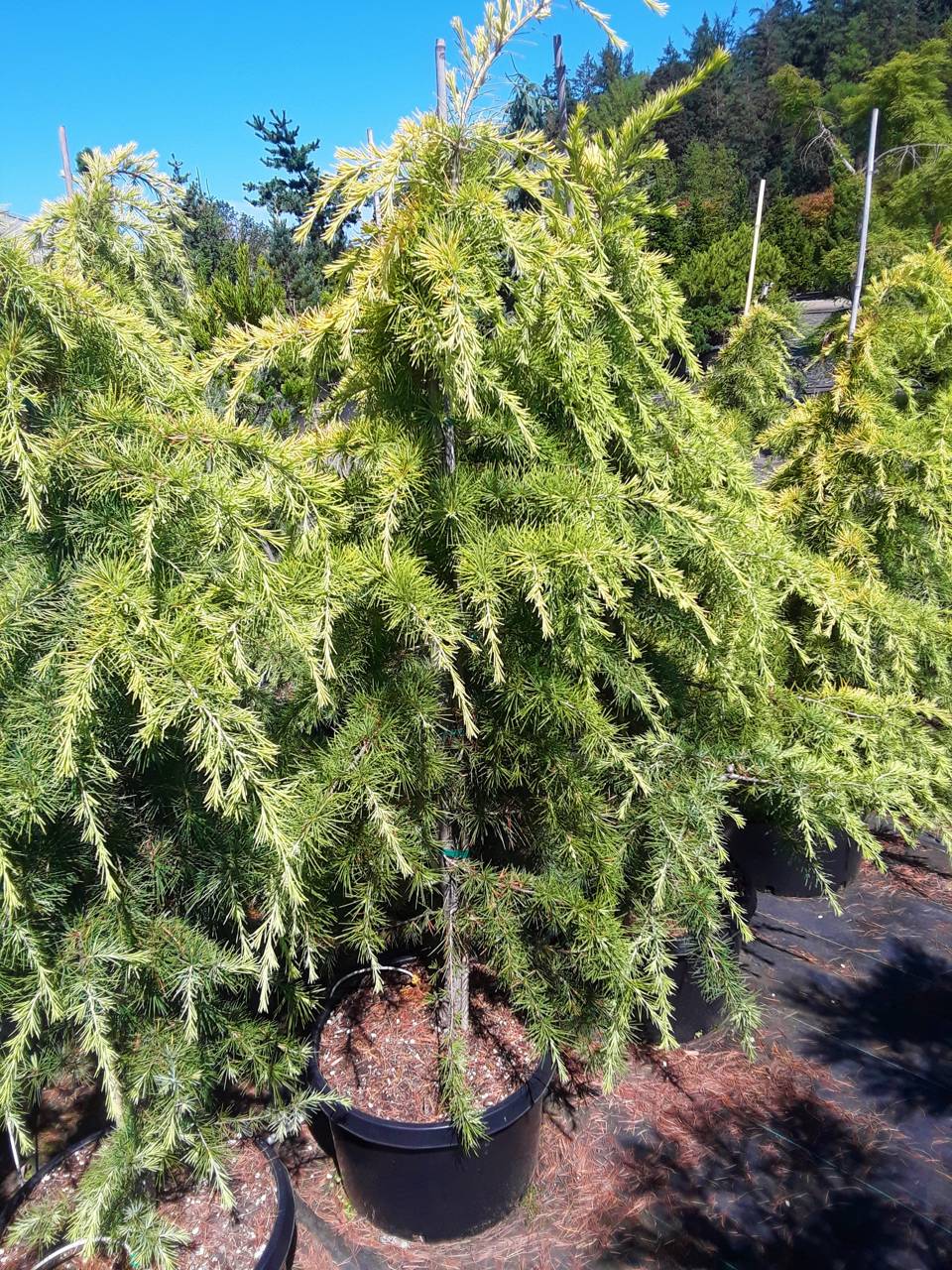
Conifers with Unique Forms
The conifers in this category could also be classified as randomly intriguing. Some plants have showy cones, others have twisted needle or branch shapes, and a few are just too unique for words.
These plants tend to have sporadic growth patterns. Some benefit from careful pruning that enhances their natural growth habit, but these conifers do not do well as hedges or shaped specimen plants.
Most of these dwarf conifers are rare plants, and they are only available from a few specialty growers in the United States.
Krejci European Larch
Larix decidua ‘Krejci’Needle Color: Green
Cone Color: Brown
This larch is unique for a variety of reasons; namely, its tufts of irregular, twisted needles spaced along the branches. This conifer is also deciduous, and as the needles drop in the fall, they reveal contorted branches. This spunky plant began life as a mutation from a more common European larch, but the needle pattern was so interesting that it was propagated and has become a quirky addition to many landscapes.
Plant Profile:
- Height @ 10 Years: 4’
- Width @ 10 Years: 3’
- Hardiness Zone: 2-8
- Sun Exposure: Sun
- Soil Preference: Sandy-loamy, well-drained, slightly acidic
-
Pest Resistance:
- Essentially disease-free
- Deer
-
Pest Vulnerability:
- Honey fungus
- Canker
- Container Plant: Yes
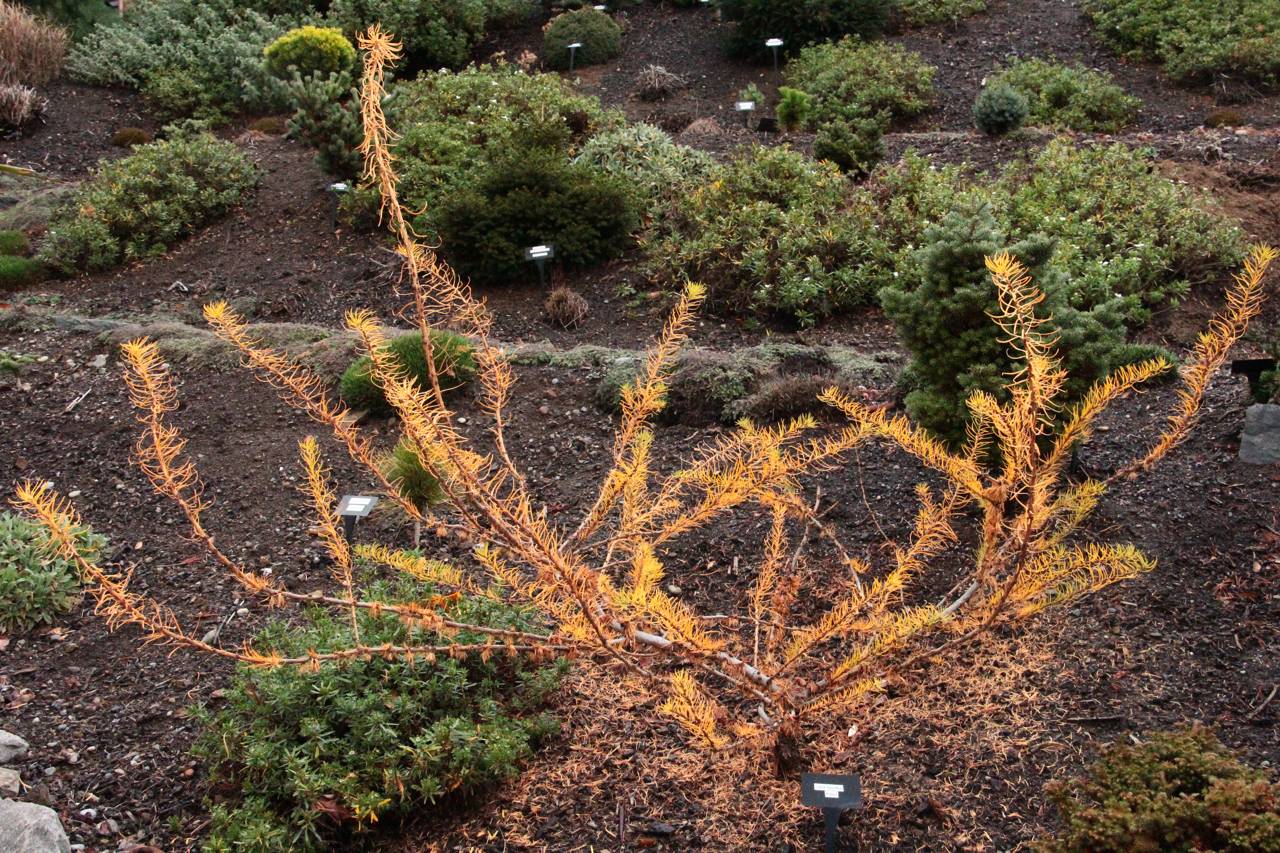
Weeping Blue Alaskan Cedar
Cupressus nootkatensis ‘Glauca Pendula’Needle Color: Green
Cone Color: Brown
This weeping cedar has beautiful deep green needles and elegant, weeping branches. The tree has such a graceful form that mature branches look as though they are draped in ice. This variety is extremely shade tolerant and can reach over 10’ tall.
Plant Profile:
- Height @ 10 Years: 12
- Width @ 10 Years: 3’
- Hardiness Zone: 4-8
- Sun Exposure: Sun/Part Shade/Shade
- Soil Preference: Rich, well-drained, slightly acidic
-
Pest Resistance:
- Deer
-
Pest Vulnerability:
- Aphids
- Honey fungus
- Phytophthora root disease
- Container Plant: No
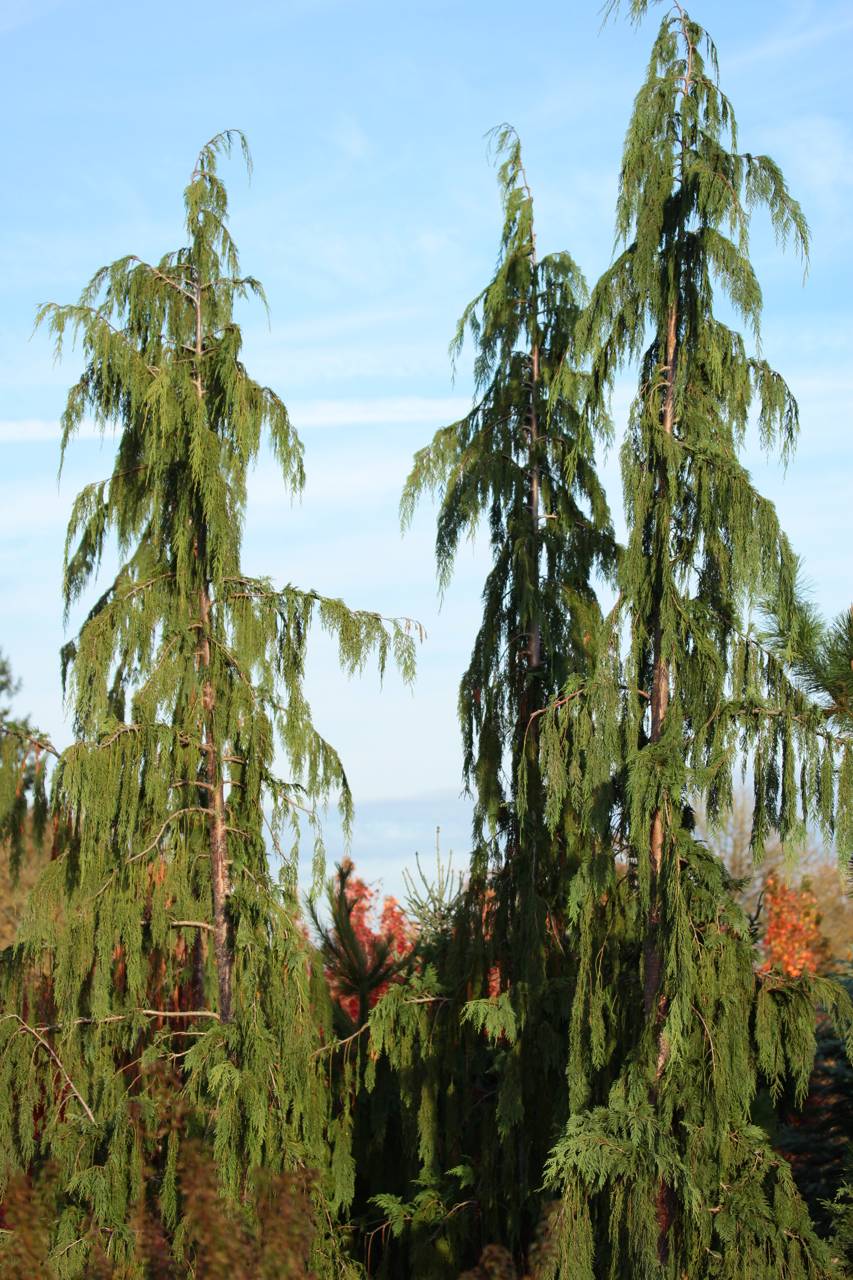
Bruns Weeping Serbian Spruce
Picea omorika ‘Pendula Bruns’Needle Color: Green
Cone Color: Red
This is considered one of the “weepiest” weeping spruce varieties. The branches are so relaxed that the tree becomes quite narrow as it matures, while the branches hang down in layers and provide a dense, blue/green carpet that drapes over the rigid trunk. This conifer can be grown farther south than most conifers, although it can’t tolerate the extreme summer conditions of south Florida, Texas, and California.
Plant Profile:
- Height @ 10 Years: 7’
- Width @ 10 Years: 2’
- Hardiness Zone: 3-9
- Sun Exposure: Sun
- Soil Preference: Sandy-loamy, well-drained, slightly acidic-slightly alkaline
-
Pest Resistance:
- Deer
-
Pest Vulnerability:
- Aphids
- Adelgids
- Conifer red spider mite
- Container Plant: No
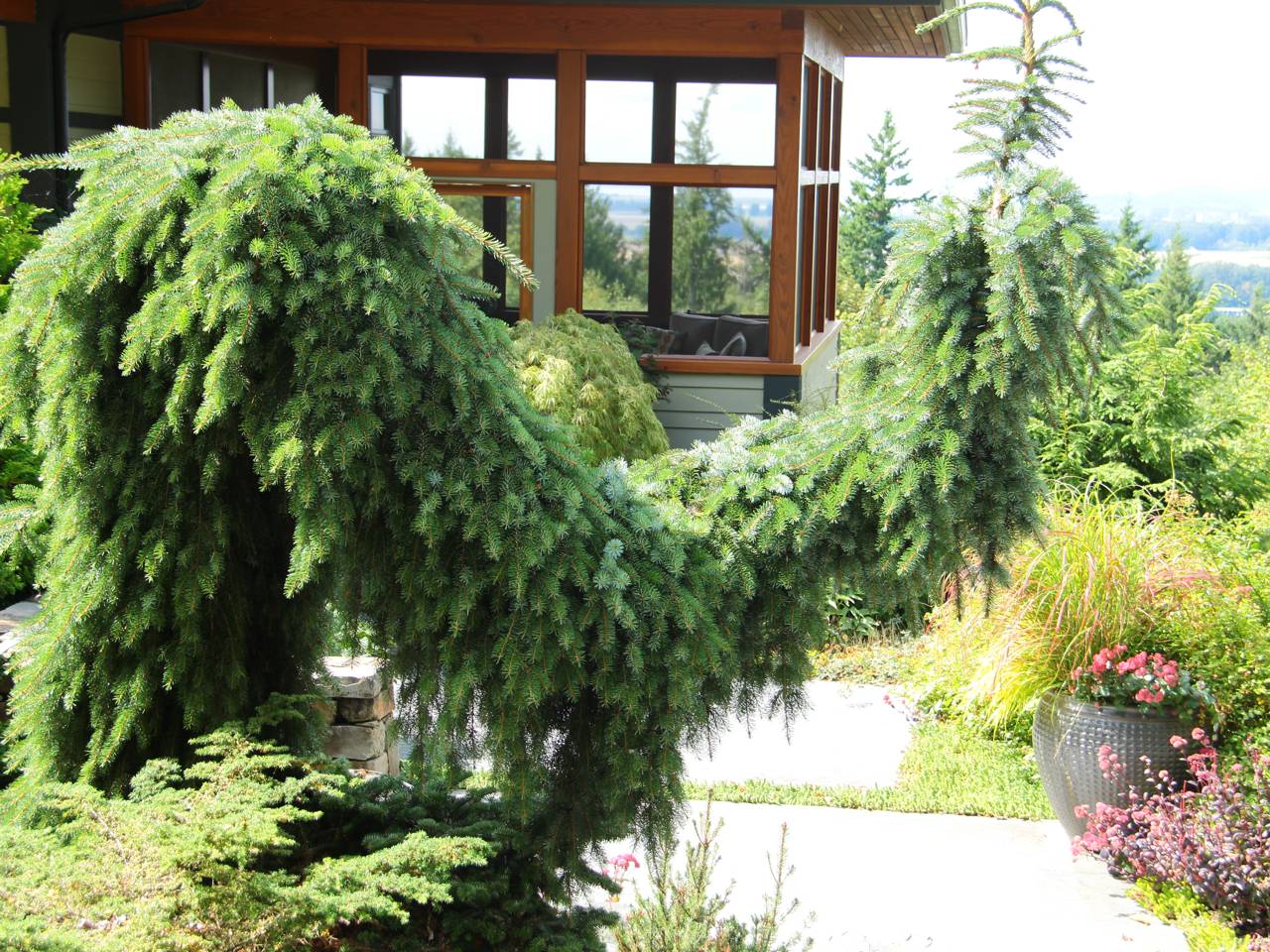
Malonyana Holub Arborvitae
Thuja occidentalis ‘Malonyana Holub’Needle Color: Green
Cone Color: Brown
Dense, dark green foliage tightly covers the branches of this dwarf tree, which give it an odd, random growth pattern. The needle size can vary, which adds to the illogical nature of this plant’s growth habit. However, this arborvitae is easy to prune into a more predictable shape while maintaining the unique character of the branches.
Plant Profile:
- Height @ 10 Years: 4’
- Width @ 10 Years: 2’
- Hardiness Zone: 4-9
- Sun Exposure: Sun/Part Shade
- Soil Preference: Sandy-loamy, well-drained, slightly acidic
-
Pest Resistance:
- Deer
-
Pest Vulnerability:
- Bagworms
- Spider mites
- Scale
- Leafminers
- Container Plant: Yes
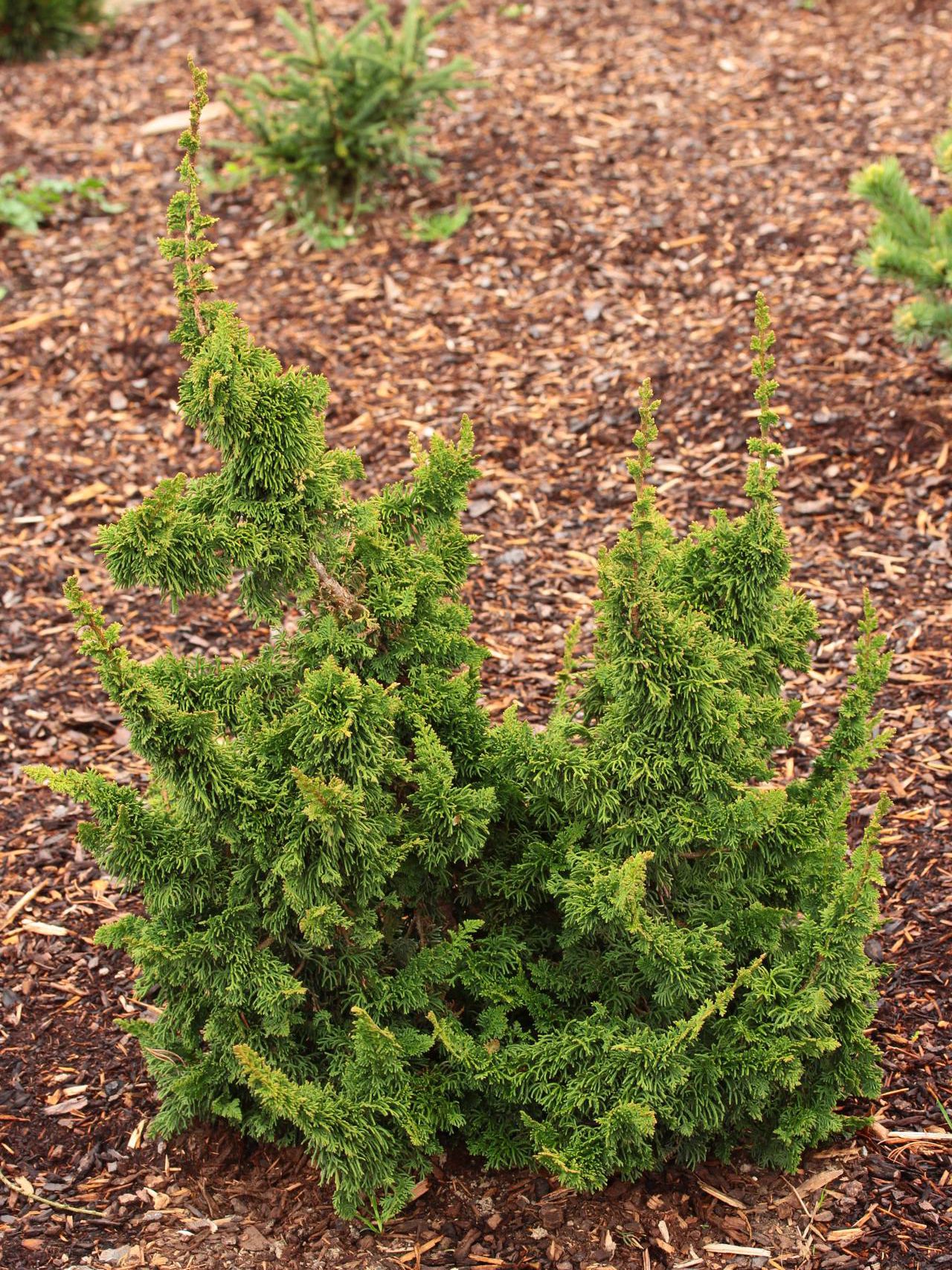
Wissel’s Saguaro Lawson False Cypress
Chamaecyparis lawsoniana ‘Wissel’s Saguaro’Needle Color: Green
Cone Color: Brown
This dwarf tree has a consistent upright growth habit that resembles the saguaro cactus; hence the reference in the cultivar’s name. The needles are a deep green color, and they are packed tightly along the tree’s curvy branches. This ornamental conifer has become quite popular in parks and playgrounds, and it has even naturalized into the wild in some parts of the United States.
This conifer is tolerant of pollution.
Plant Profile:
- Height @ 10 Years: 6’
- Width @ 10 Years: 2.5’
- Hardiness Zone: 5-8
- Sun Exposure: Sun
- Soil Preference: Sandy-loamy, well-drained, slightly acidic
-
Pest Resistance:
- Deer
-
Pest Vulnerability:
- Nothing significant
- Container Plant: Yes
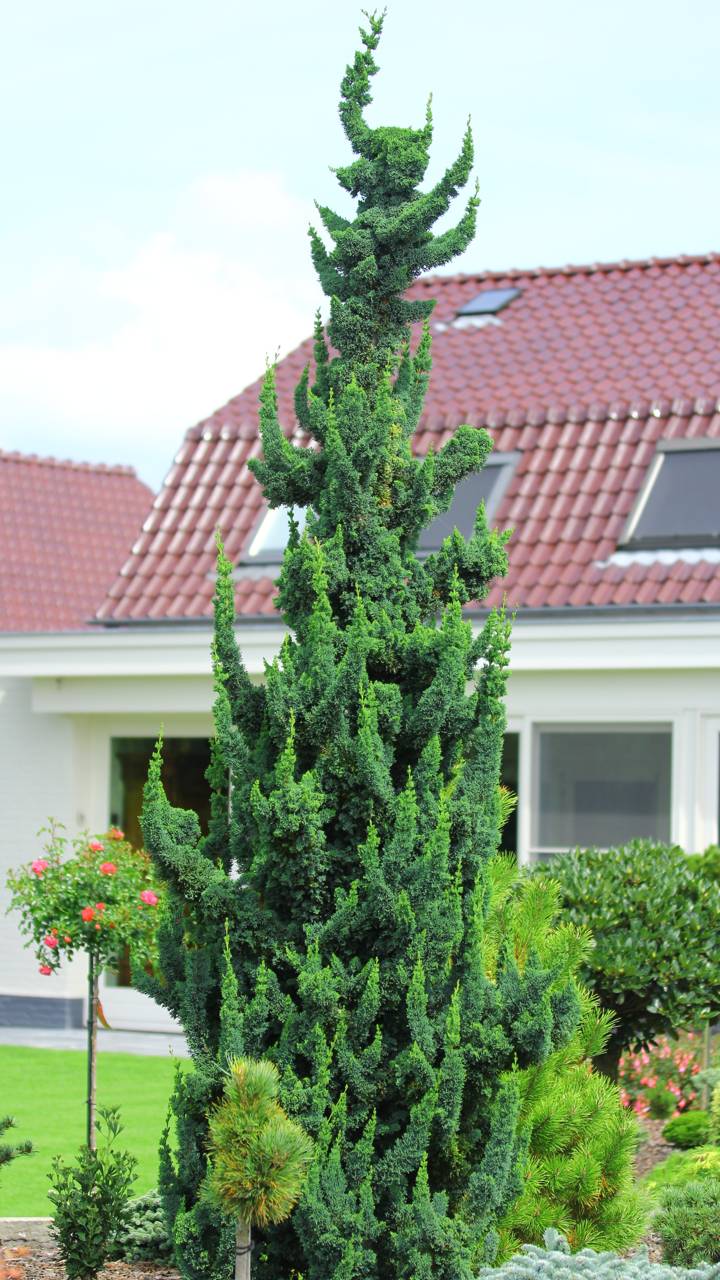
And there we have it! You should be well on your way to choosing which specimen conifers will compliment your home and landscape.
Remember- most of these plants are considered rare, and they can only be purchased at specialty growers. Find a reputable supplier and order certified nursery plants.
Happy planting!